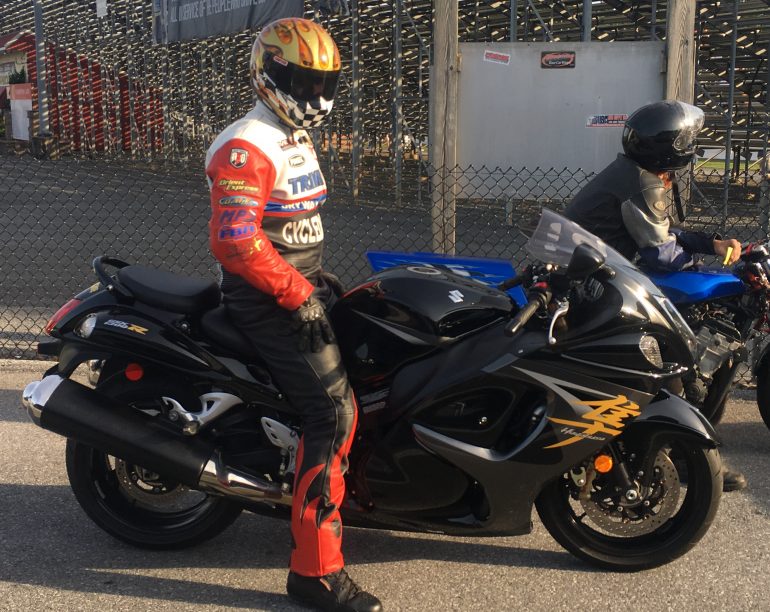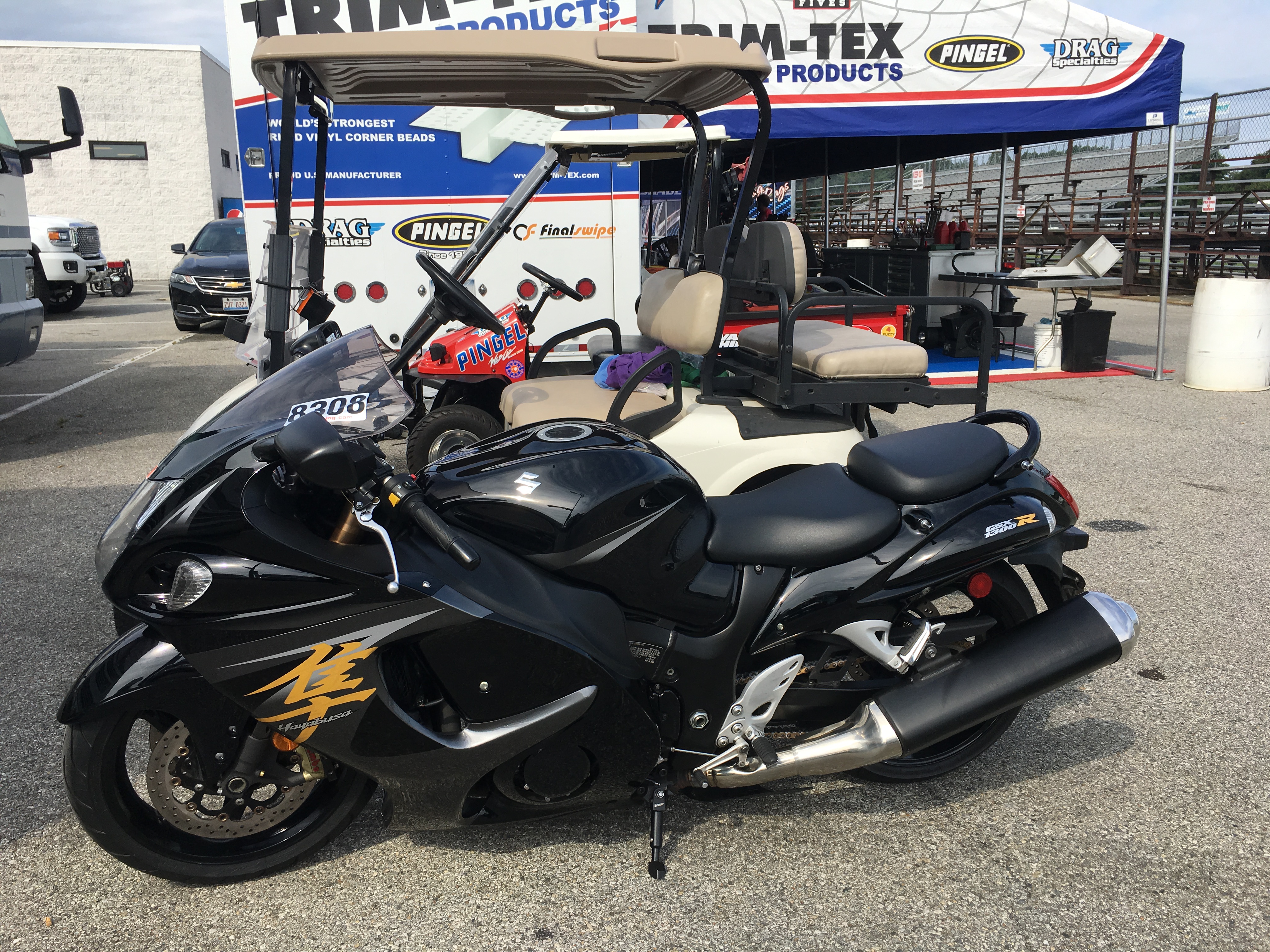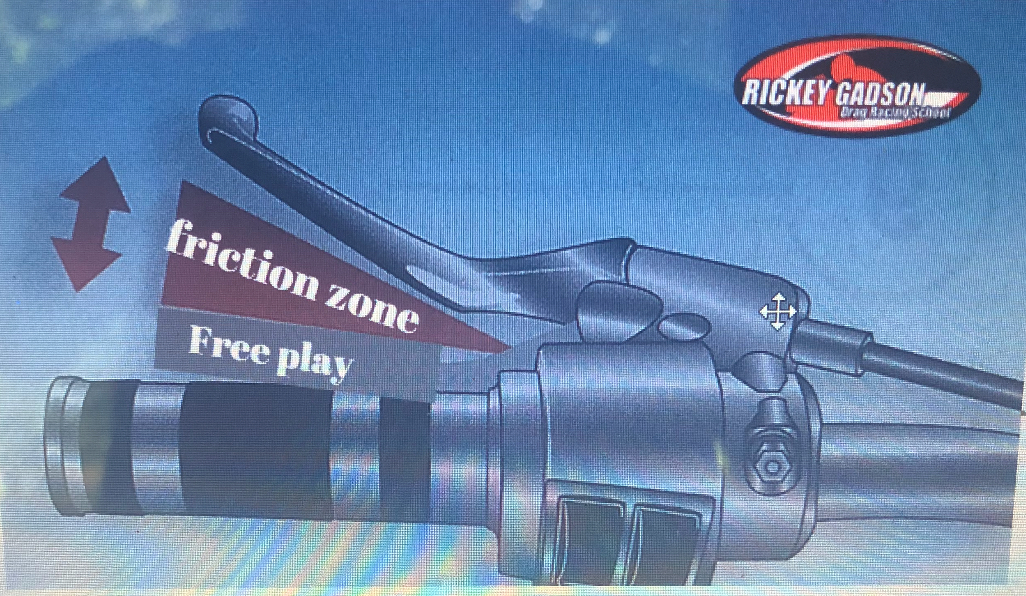Is it still possible to ride your race entry to the drag strip? Can a rookie pull it off? Strap on your helmet and come along for this ride because Cycledrag.com’s Jack Korpela has a lot to learn.
This project aims to capture the pure essence of what first inspired Street ET motorcycle drag racing. It also aims to encourage other motorcycle enthusiasts to give this sport we love a try. So please, feel free to pass this article on to that one friend we all seemingly have who always wanted to go down the track, but didn’t. If a novice like me can do it, they certainly can as well. And together, maybe, just maybe, we can grow this sport.
The goal is to build a practical and serviceable street – strip Suzuki Hayabusa . The objective is to go racing without completely losing one’s favorite street bike.
Now here is where the project takes yet another swerve. In the spirit of the anti-trailer queen, ride-hard philosophy, the goal is to be able to ride it to and from the track. Instead of a pseudo-street bike, that is in reality a purpose-built dragbike, we want to be able to hit the road. No trailer needed! Is it possible to keep it this simple? We shall see.
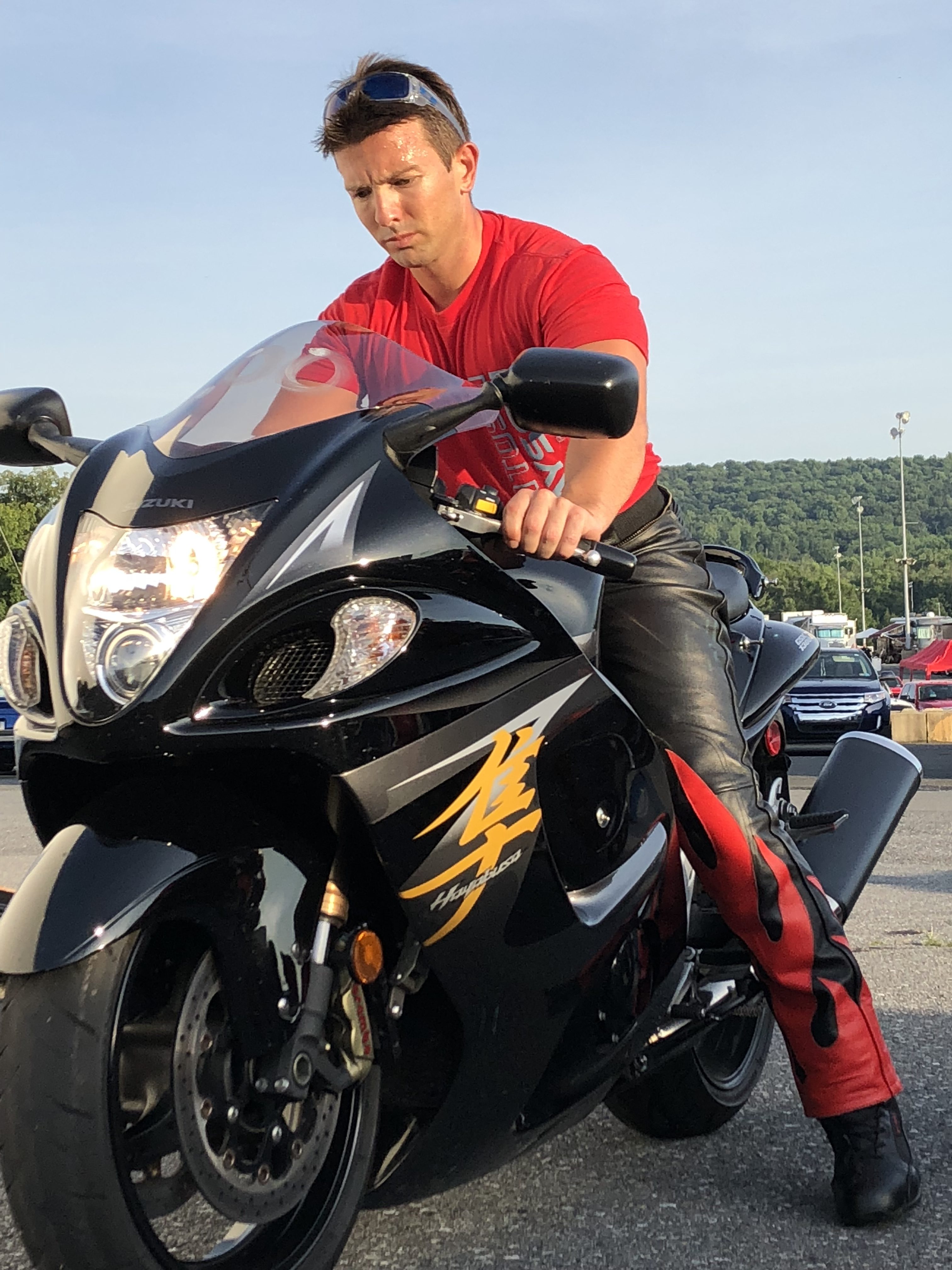
“Pump gas!” I remember my friend Tony Razor emphatically telling me about a decade ago as we traveled back from a race together. He had just completed some significant upgrades to his Hayabusa and subsequently blew it up on the famous Atco, New Jersey drag strip. On the ride home Razor told me if I ever wanted to get involved as more than an announcer, to keep it simple in the beginning. Keep it on pump gas he said. It was a lesson I never forgot.
I have been following the dragbike racing and the motorcycle world closely since I was a kid. I’ve continued my childhood passion as an announcer, promoter and journalist with Cycledrag.com. One of the truly compelling aspects of the sport is the numerous amount of different combinations, categories and set-ups teams dedicate themselves to building. Dragbike racers are a small group, but there is a lot of diversity.

As a whole, dragbike racers seemingly have the same mission. It’s all about turning the win light on. However, there are enough sub groups and factions to quickly confuse someone new to the sport. There are Top Fuel racers striving for world records with virtually no limitations, nitrous and turbo Pro Mod machines looking for the best 660-foot times, Pro Street racers in search of rapid elapsed times without the use of wheelie bars, Pro Stock racers competing with gasoline and no special adders; the list goes on. Even in bracket racing, which is designed to include everyone, there is division. There are no-delay box, bottom bulb racers and then there are a group that like to compete with as much technology as possible. As one expert once explained to me, for a smaller niche sport it’s amazing how widely the different cliques of dragbike racing vary. A great example is how different an all-Harley race is from a typical sport bike event.
I’ve always believed that all motorcycle drag racers need to stick together for the greater good of the sport.

The sport is also constantly evolving. The street-worthy motorcycle that can still go out and turn on win lights in the ET class is one particular build I feel has become rare, vis a vie two decades ago. There was a day when the casual competitor rode to the track.
These days most bracket racers opt to buy a designated street bike for the road to complement their dragbike. Dan Rudd of MPS is a prime example. He has some amazing Hayabusa race bikes and a comfortable full dresser Harley for the road. It’s a common path when the race bikes become more exotic and less street worthy.
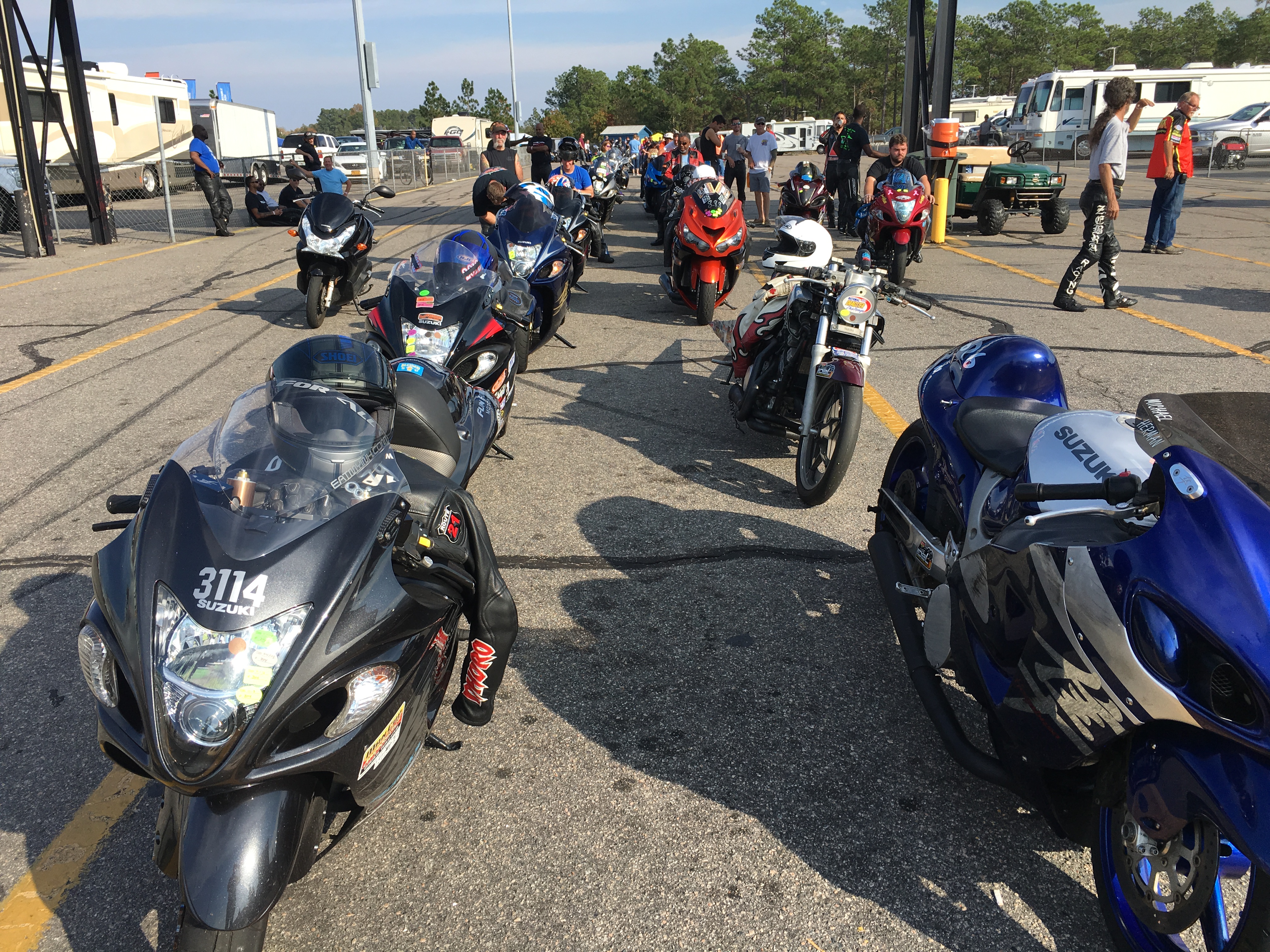
The reasons why the sport has turned to mostly race-only machines are easy to see. Most of the parts that are applied to a street bike to increase the competitive advantage at the track are going to take away usability and dependability on the street. A 10-inch over swing arm can’t be much fun on a long trip to Tail of the Dragon. An all-out race motor isn’t going to be very dependable. A MTC Gen 2 clutch is amazing on the track but won’t get you far on the road. Plus most enjoy the peace of mind that comes with not racing a daily driver. If something breaks at the track, simply put it back in the trailer.
Yet I remember a day when even Pro Street, Street Bike Shootout as it was known back then, was subject to a 20-mile road course on race day.
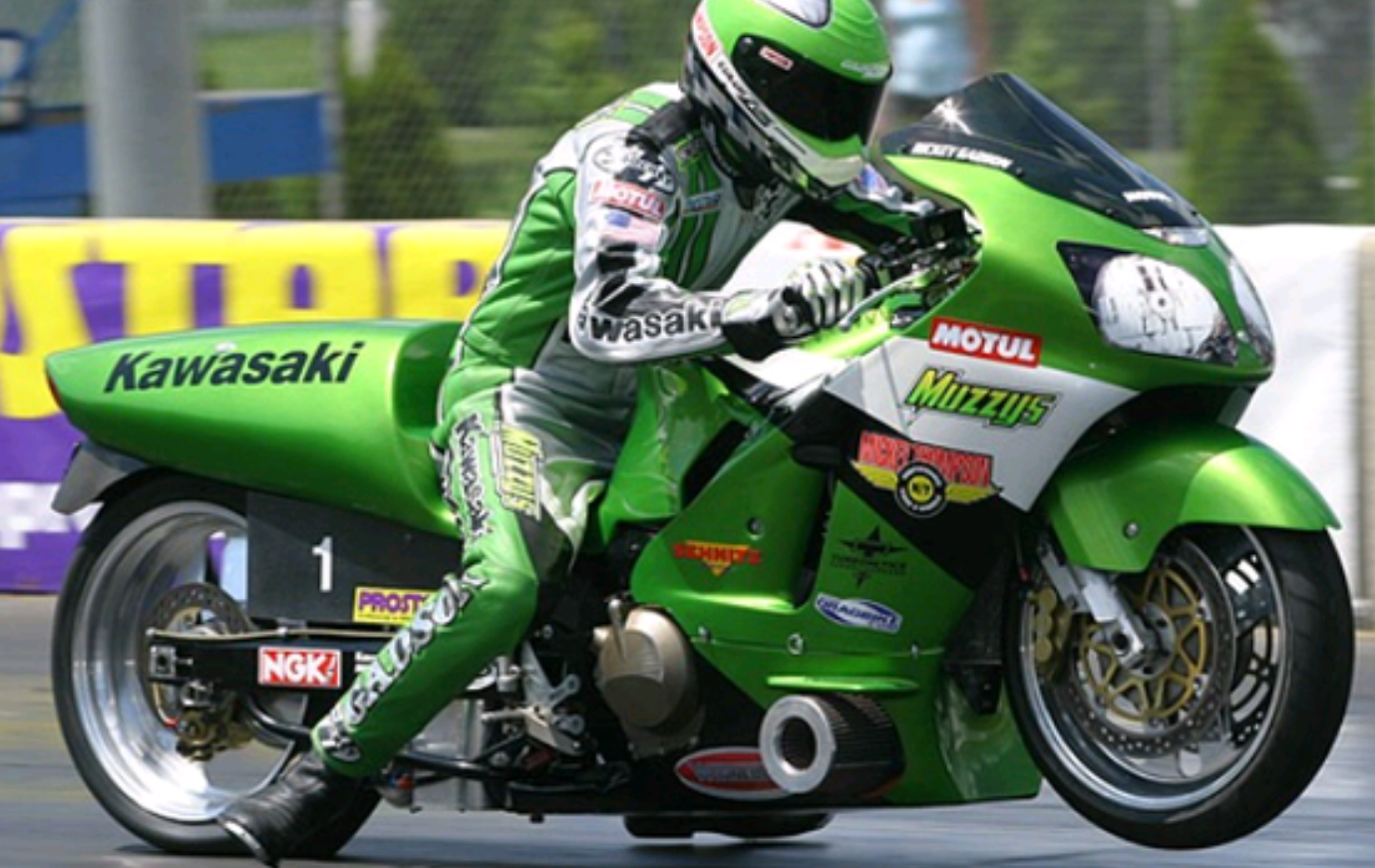
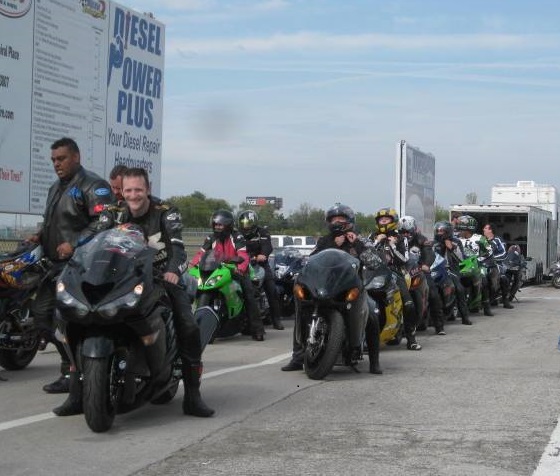
There have been so many great motorcycle drag racing memories for me throughout the years. One of the most pure, enjoyable eras is when I used to hop on the back of my dad’s 1978 Kawasaki LTD KZ 1000, ride to nearby Keystone Raceway in New Alexandria, Pa., race all day or night, then ride home. It’s when I truly fell in love with the sport.
The incredible versatility of the motorcycle made for such an enjoyable and unique experience. Once we got to the track, all you had to do was let some air out of the rear tire, unscrew the mirrors, shoe polish a number on it, and get it in the lanes. It was drag racing at its purest form.
My father racing his street bike circa 1999 at Keystone Raceway –
Those fond memories proved to be the inspiration for this project.
I’ve spent plenty of time at the races announcing and watching the computer screen to know that even Street ET, a class originally designed to encourage beginners, has become a merciless sea of some of the nation’s most talented and consistent bracket racers. The sport really changed when the Hayabusa came out in 1999. To stand a chance in that class you better have a proper bike set up and a consistent riding style.
I do feel motorcycle drag racing needs a beginner class to encourage folks just starting out, but that is a conversation for another day.
I have the utmost respect for purpose-built dragbikes, and boy are they fun to watch. However there is something special about a machine versatile enough to ride to a drag strip 500 miles away, race and ride home. It sure makes the trip a lot more fun.
Brock Davidson of Brock’s Performance, the first man to put a street bike in the seven-second zone was a big influence for this project. Long ago Brock told me he would get bored watching his wheelie bar bike sit in his garage most of the time and talked about how he put hundreds of miles on his legendary Suzuki Bandit at Daytona Bike Week the year he propelled it to the historic seven-second pass.
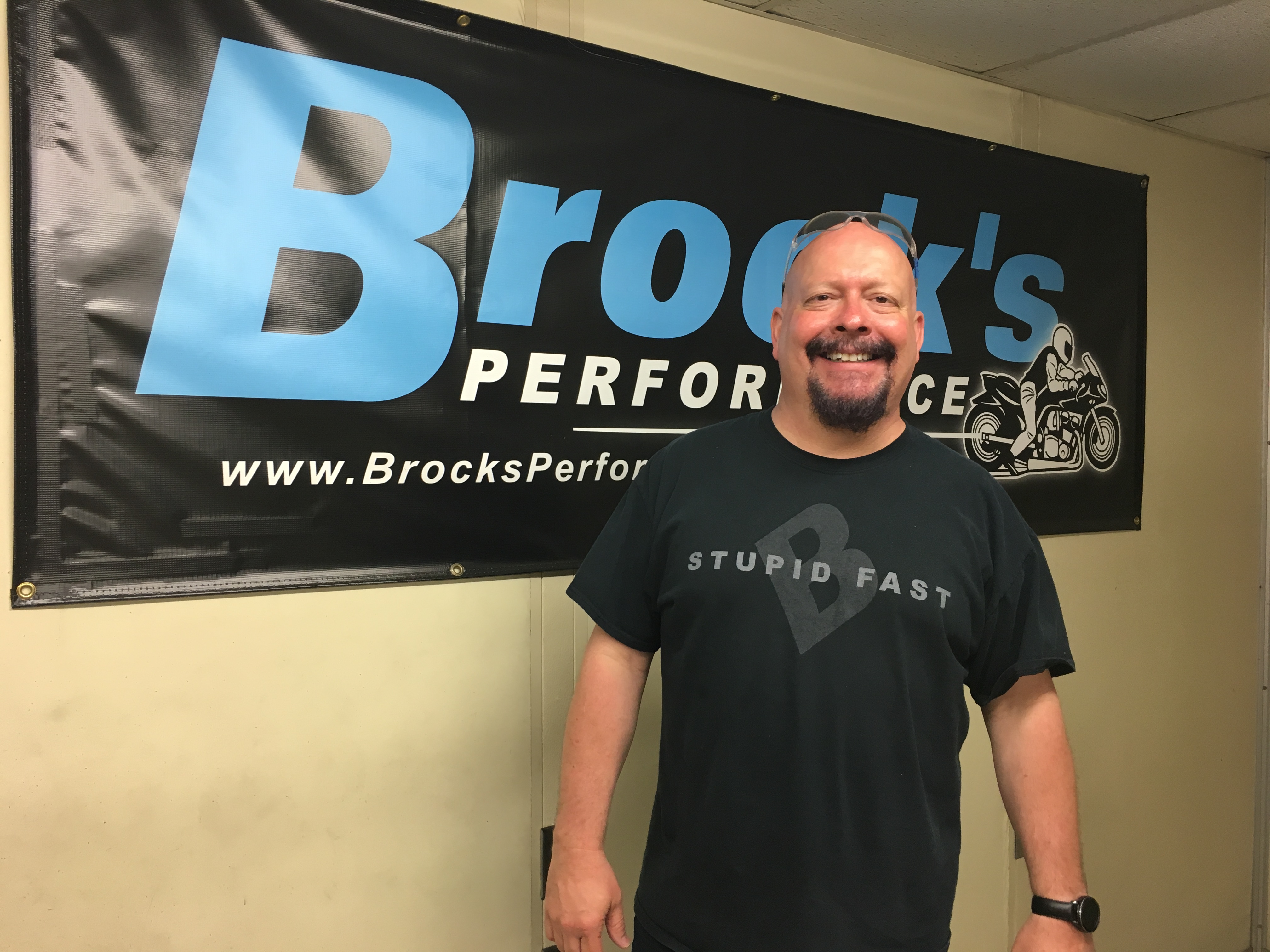
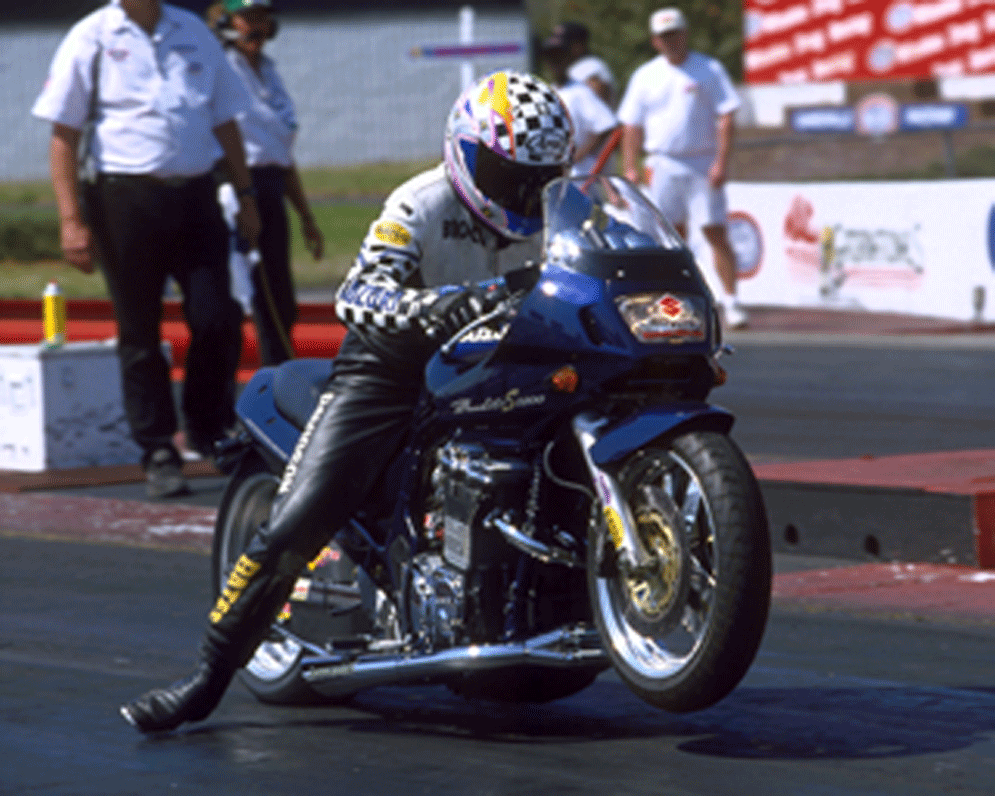
After a few years of ownership of my 2014 Hayabusa I can see where Davidson is coming from. I’ve said my share of prayers before hitting the mean and unforgiving streets, filled with texters and distracted drivers. Fortunately I have stayed safe and have enjoyed a lot of fun. I’ve had the bike to Times Square, Larry “Spiderman” McBride’s shop in Newport News, Va. multiple times, Maryland International Raceway, Chicago, Pittsburgh, Rockingham Dragway and several other enjoyable locations. It’s been about 13,000 miles of fun and unforgettable sights. It’s a feature of the motorcycle I’d prefer not to lose, especially as someone just dipping their toe in the drag racing water. Besides, I’m not so sure I’ll ever be a 25-event plus a year racer.
Many will point out how the Hayabusa is not an ideal touring bike. I’ll be the first to admit it’s not the most comfortable and could use a few modifications. But it is my love for this legendary dragstrip machine that keeps me on it during long trips. A full dresser Harley may be more comfortable but very few motorcycles will offer the sensory overload the powerful GSXR 1300 does. It’s so responsive and so much fun. Suzuki has done an amazing job with this machine.
Here are some of the trips I have made.
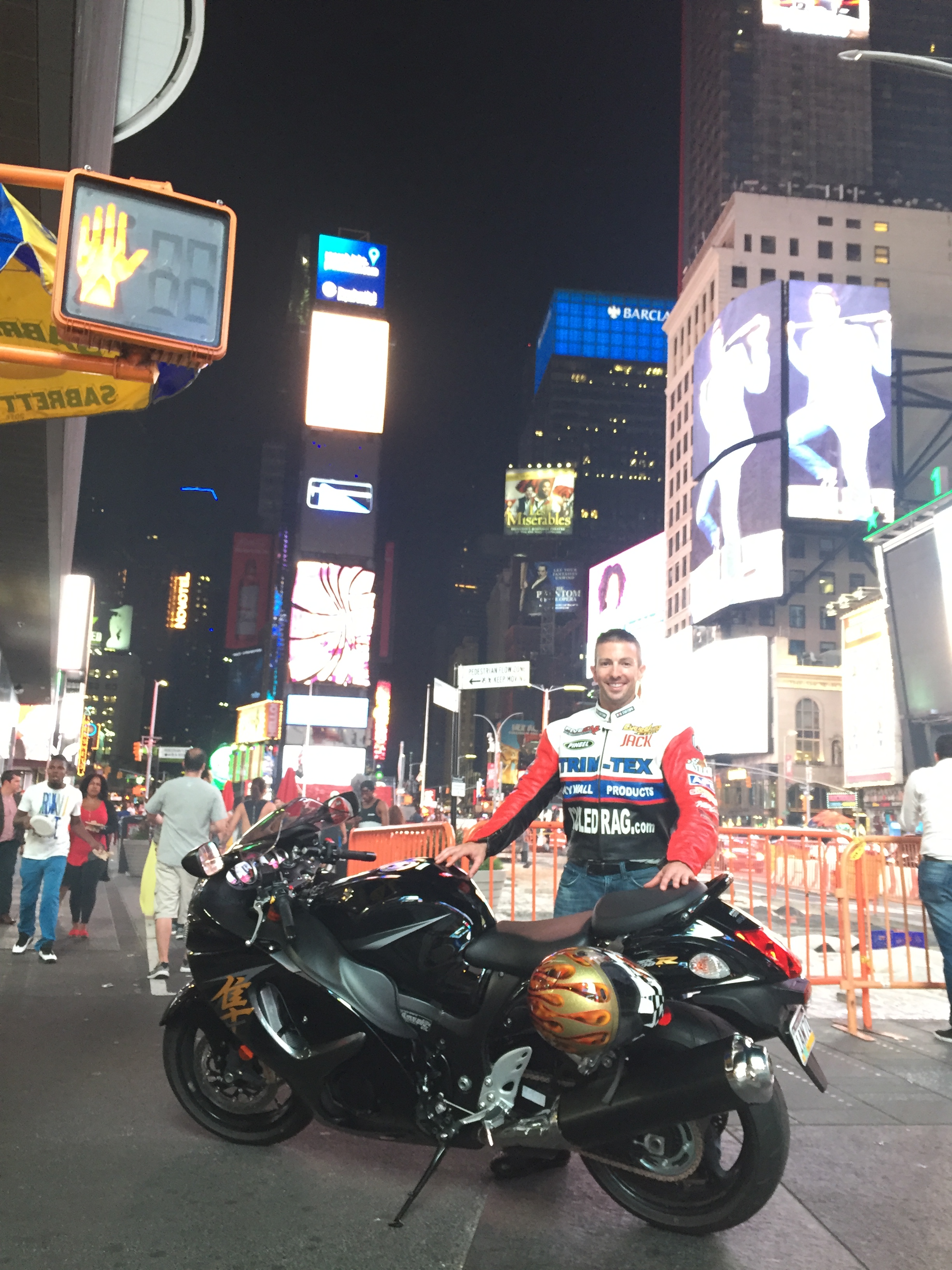
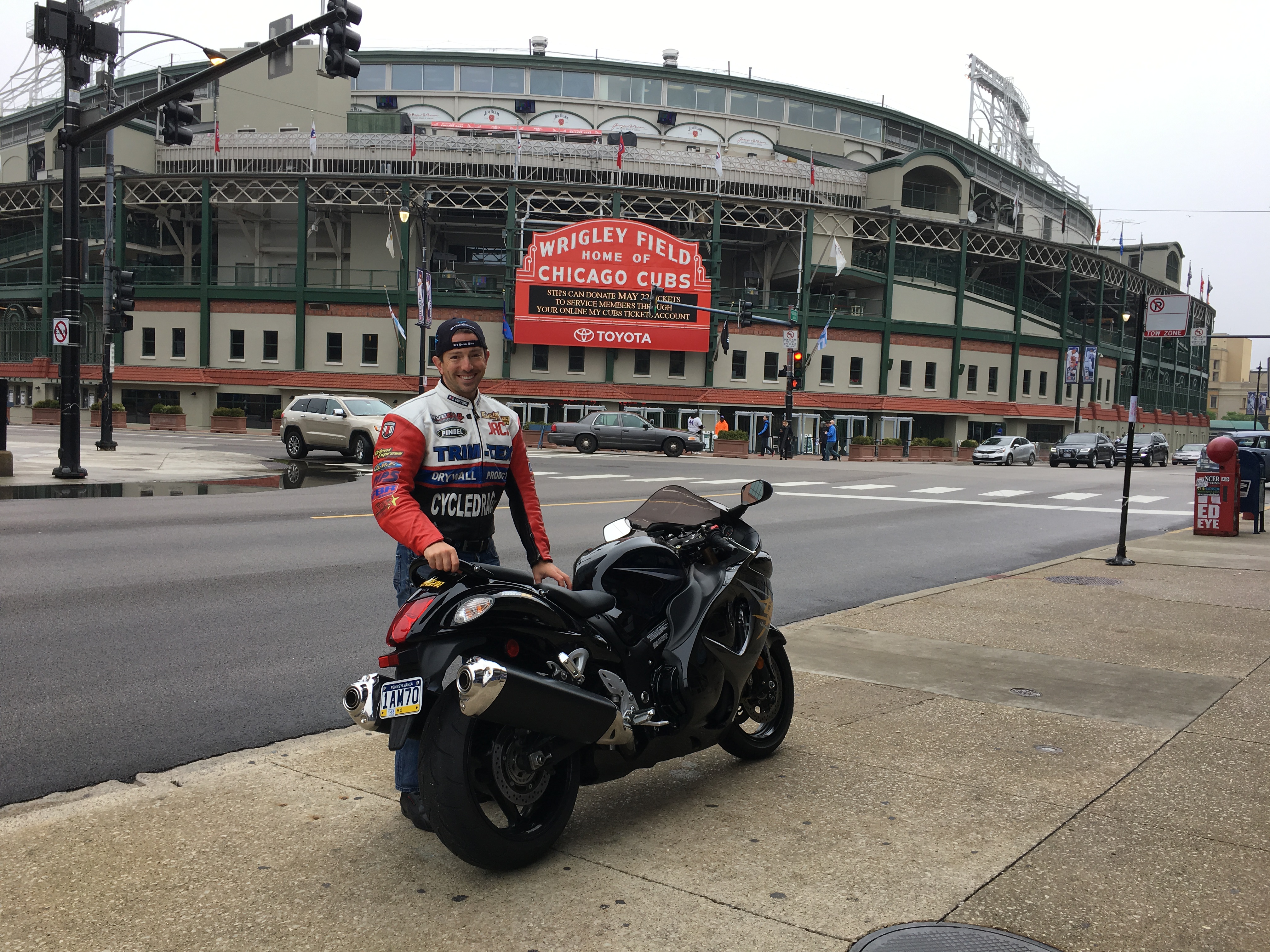
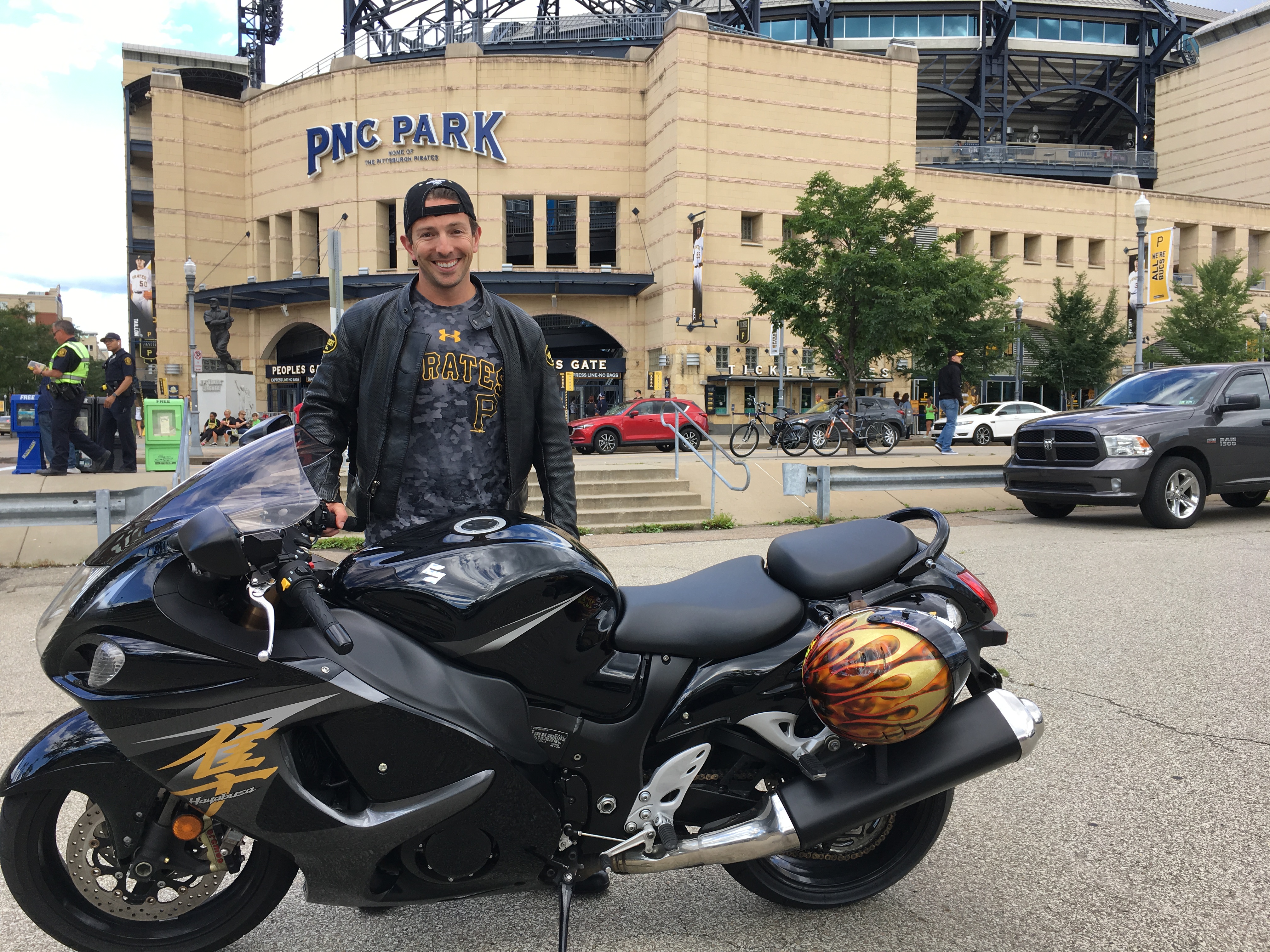
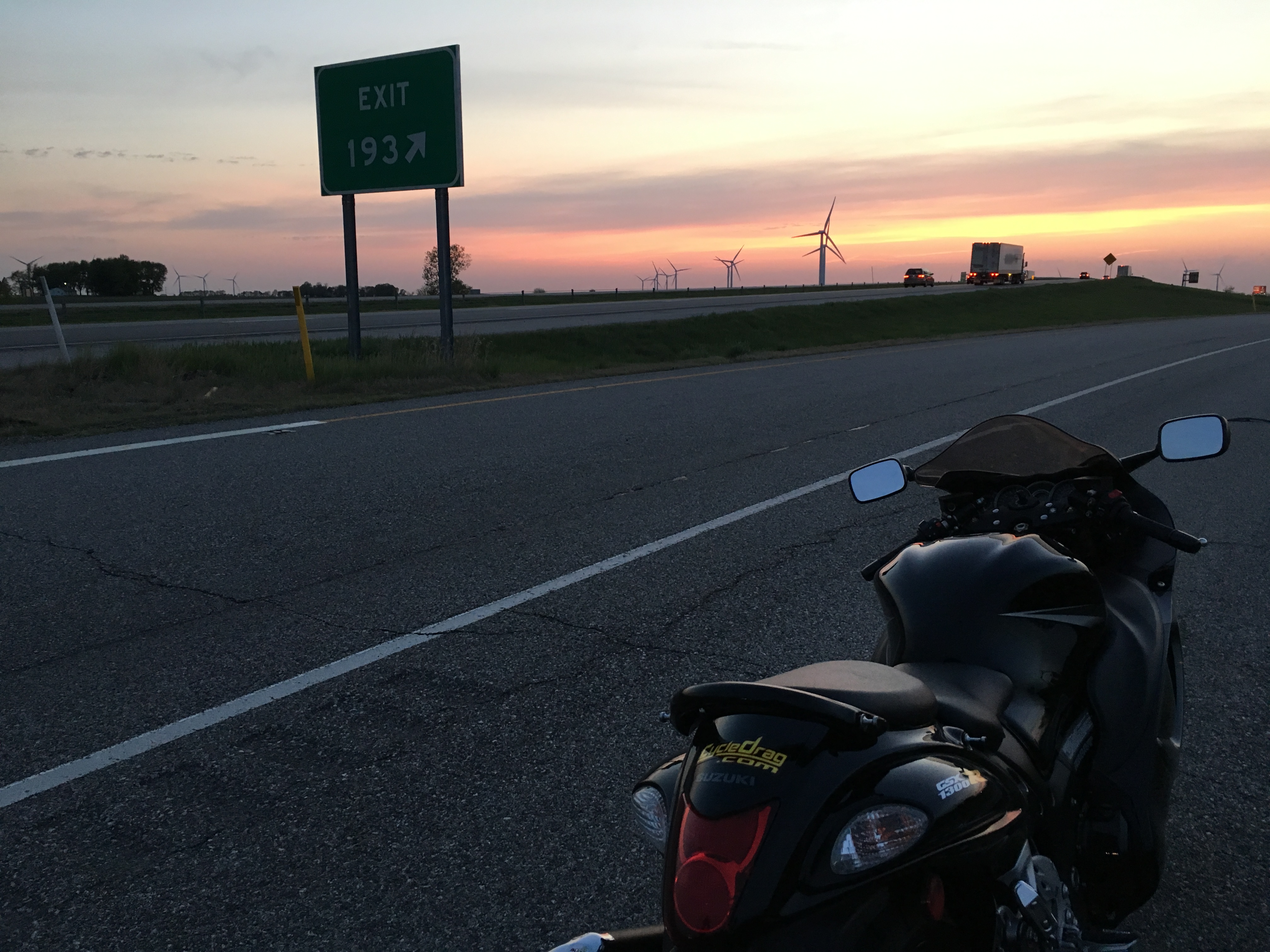
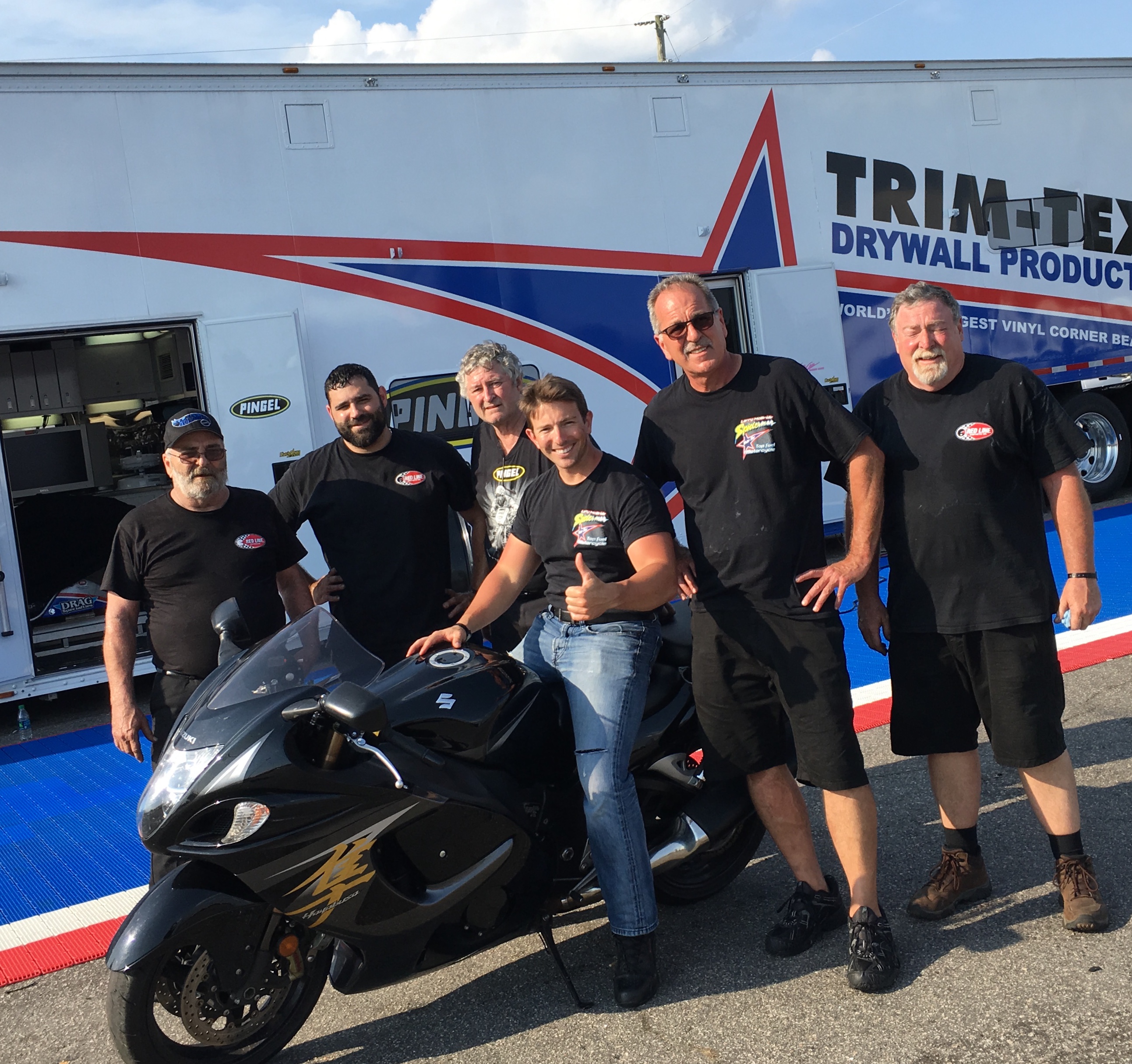
The Hayabusa is unlike anything I have ever ridden before. One advantage of the road miles is I feel the long trips have really given me a chance to get comfortable on the bike.
I feel I’ve become pretty decent at enduring those long road trips, but as a rookie drag racer I would be starting from ground zero to learn how to get the Hayabusa down the track.
To establish a baseline, I wanted to make a pass on the machine absolutely bone stock. I knew going in this would not be an ideal situation, but I figured it would be a great way to have a starting point by which I could track my progress along with my soon-to-be modified motorcycle.
This led me to a street ride about 40 miles north of my home to legendary Maple Grove Raceway in Reading, Pa.
Drag Strip Visit No. 1 – Maple Grove Raceway, Reading Pa. – June 29, 2018 – Bone Stock
I love test n’ tune nights. I used to work the test n’ tune nights at Gainesville Raceway on Wednesdays to help put myself through school at the University of Florida. I fell in love with the people and the laid-back atmosphere. It’s wholesome drag racing at its simplest form. It was a great contrast from my last trip to Maple Grove, which was for the jam-packed and highly restricted NHRA National event.
Seeing the world’s premier drag racers like John Force take center stage is cool, but it’s also pleasant to watch the everyday folks who may be trying the sport for the very first time. Laid-back and inviting events are what drag racing needs to attract newcomers and to grow.
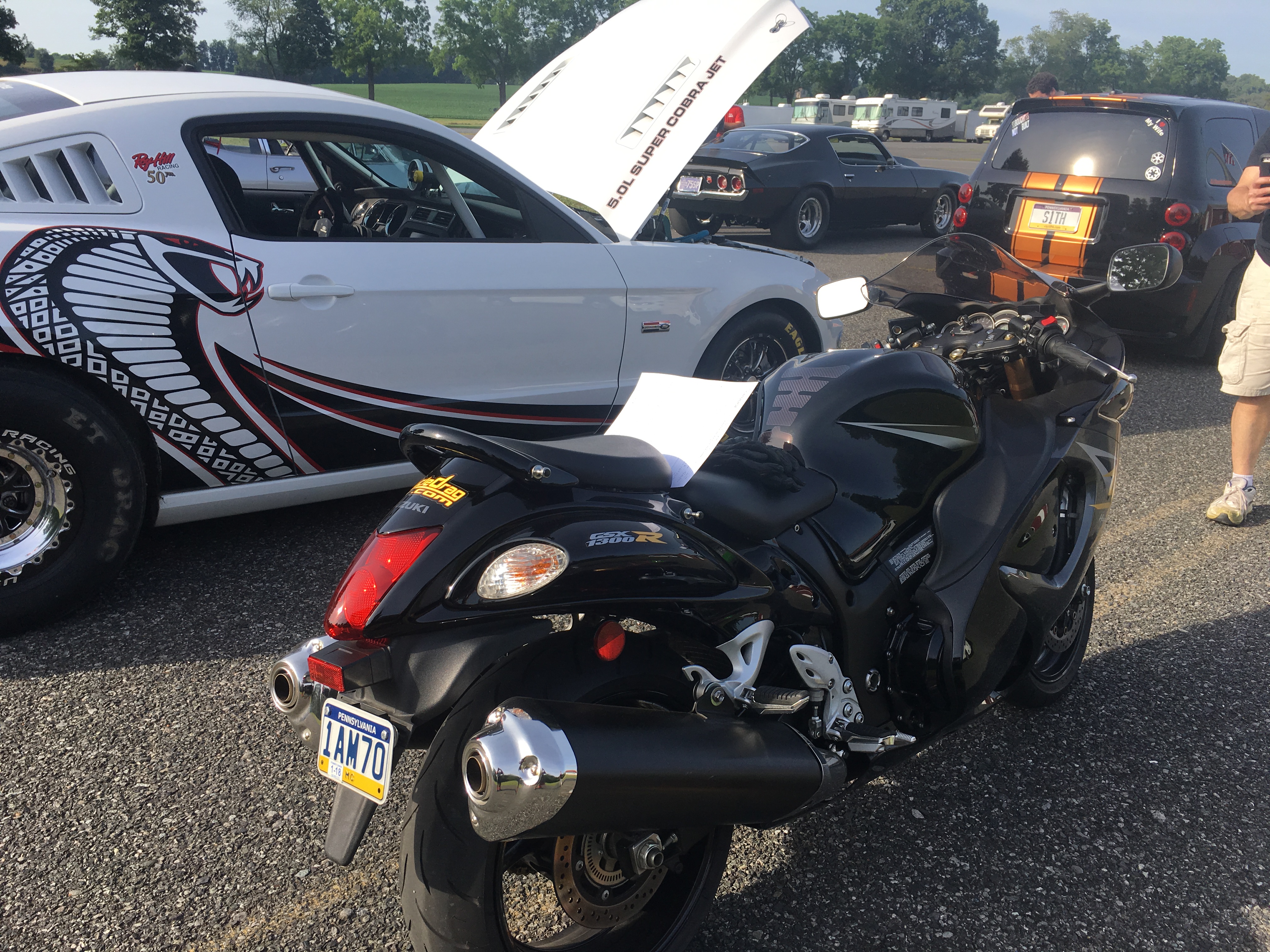
After getting through tech and putting a shoe polish number on the front windshield, I made my way over to the bike pits. I had never met any of these people before but was instantly welcomed. It’s another aspect I love about the motorcycle community; the camaraderie is the greatest. No matter where I have been in the country, or the world for that matter, the love of two wheels and a motor seems to bond people. I’m sure most of us will agree some of the best friends we have ever made have been connected to motorcycles in some way. It’s a community that always seems eager to help others.
One feeling of trepidation I had when I pulled in was quickly realized when I found that working out of a book bag would not be the easiest thing. A truck and a trailer make for a much more comfortable setup. Yet I was up for the challenge. I appreciated the folks around me even more, in the event I may need some help.
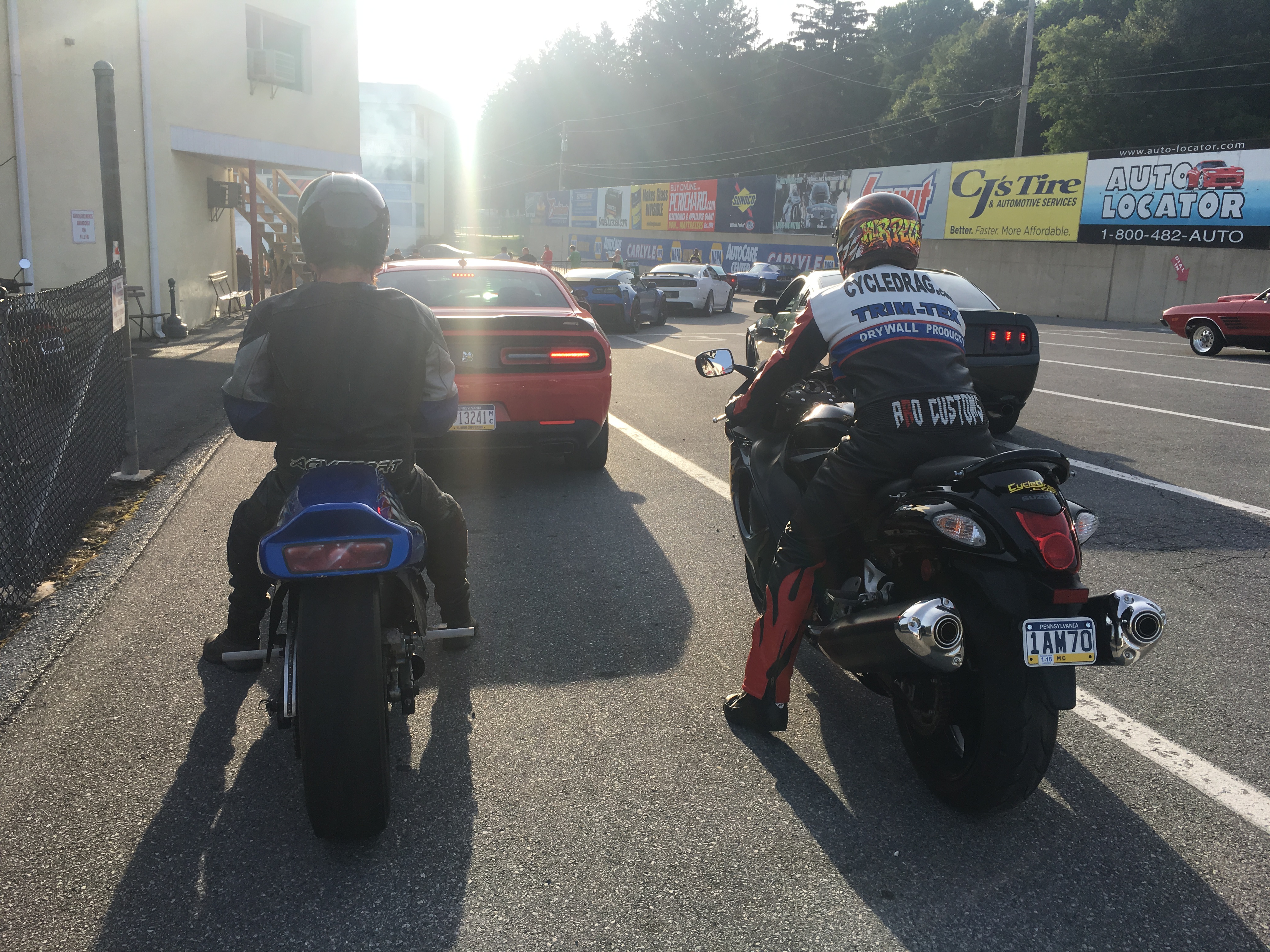
The lane call went out for the bikes and it was time to get suited up. I was surprised at how nervous I felt. I’ve been around drag racing and motorcycles all of my life but this new venture gave me a little butterfly in my stomach. I have spent hours on this bike on the road, spent years riding dirtbikes and even went down the track a few times before on my Kawasaki KZ 1000, but something was different this time.
As I crept forward in the lanes, I felt excitement too. I knew I was a lot safer on the drag strip than on the street. I didn’t need to worry about anyone pulling out in front of me.
I knew the horsepower of the Haybusa, even in stock trim, could be a handful. I did not want to be one of the many people I’ve seen over the years, no matter how experienced on motorcycle, who try to go too fast too soon and end up getting hurt. I had no problem swallowing my pride and taking some baby steps.
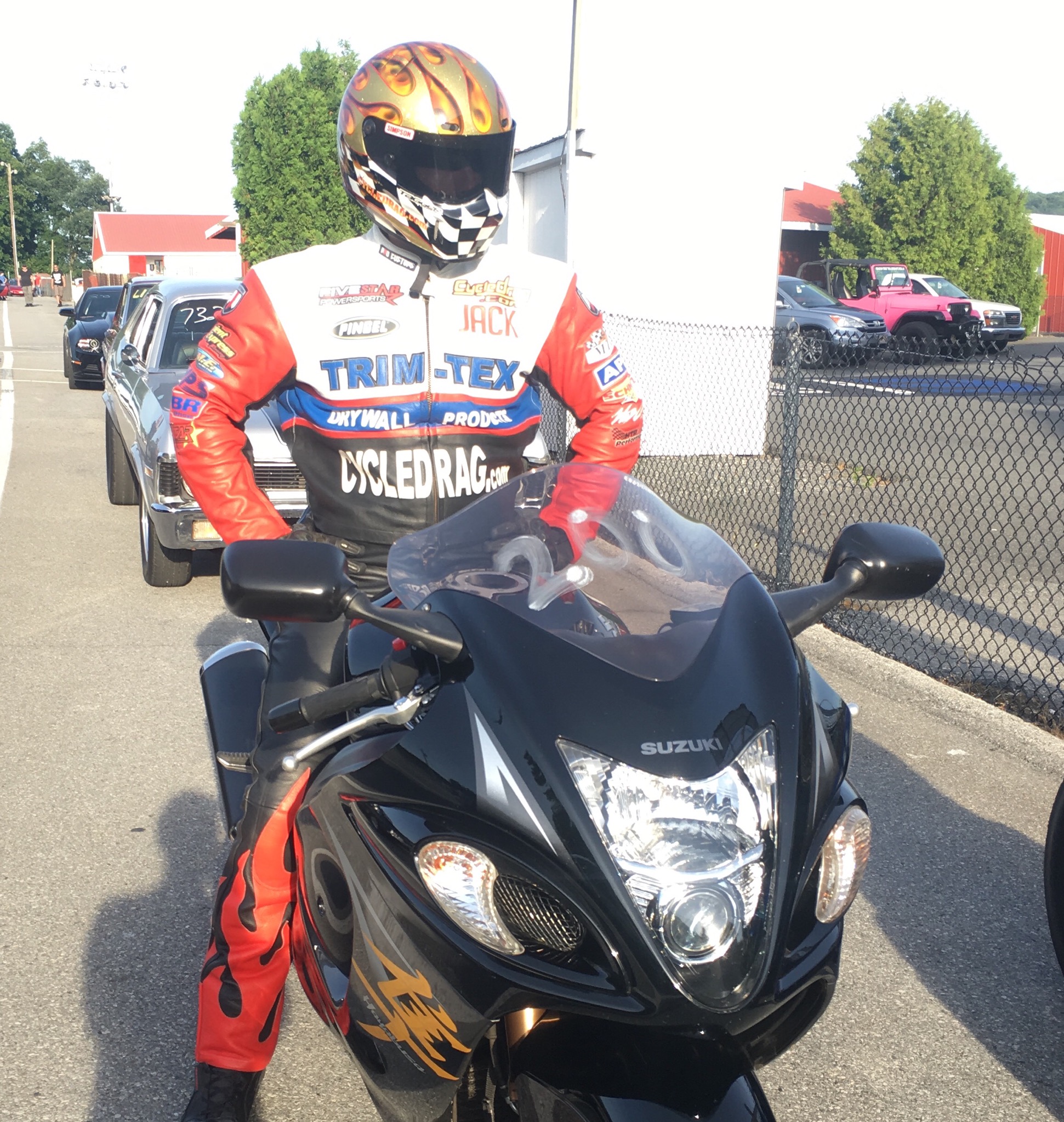
I was also comforted by something I’ve heard McBride say often, “If you are not a little nervous, park it.”
Confidence is key, but McBride and others know full well one must always respect one’s motorcycle. When taken for granted or underestimated, a bike can cause significant injury or worse. McBride says he will often have private talks with his 258-mph rocket ship to maintain the respect level.
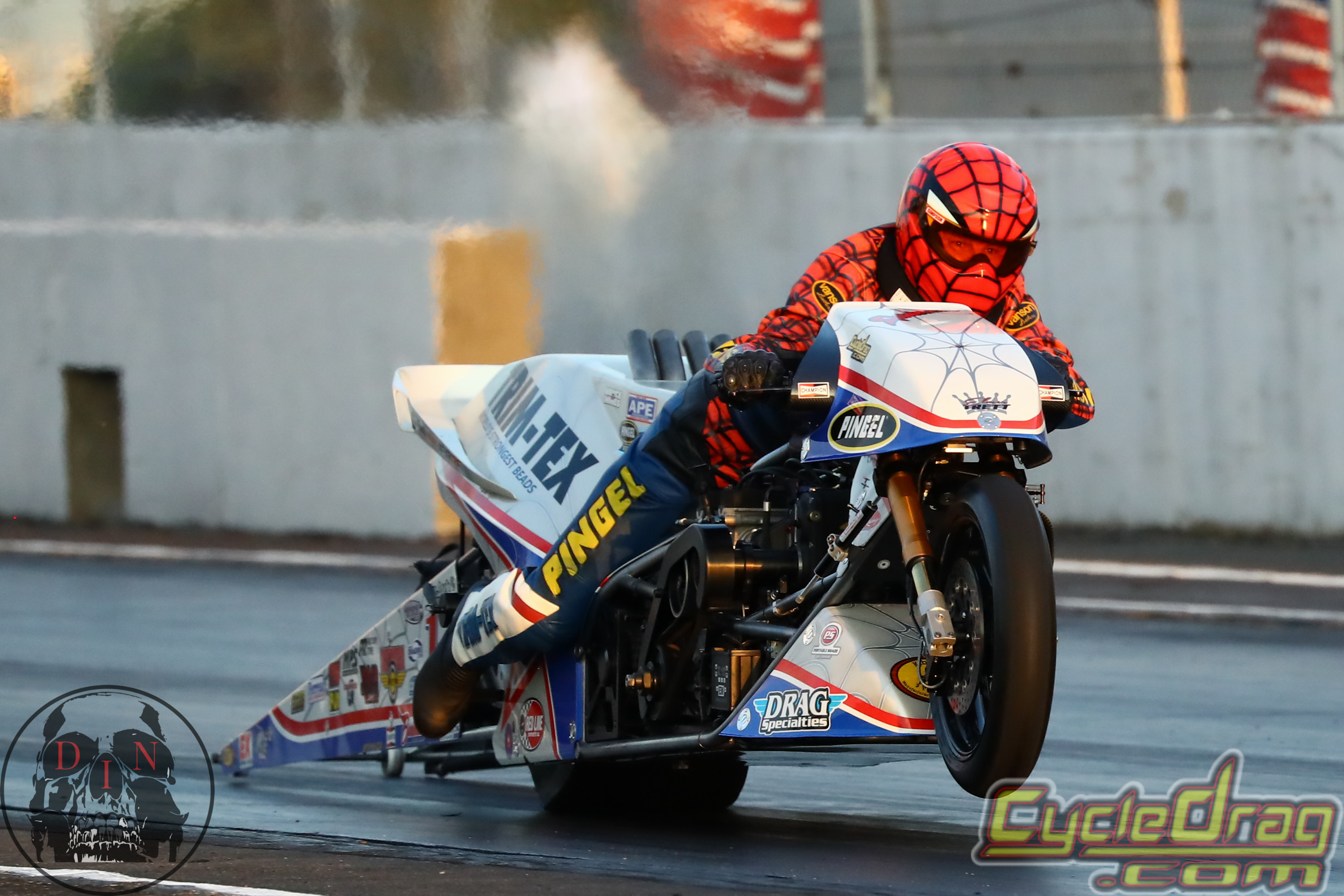
I was certainly not on anything even close to the world’s quickest dragbike of McBride, but the reality is even a Yamaha PW 50 can get somebody hurt if the respect is lost. I was determined to never lose that respect.
One concern for me is how quickly the front wheel can come up on a stock wheelbase Hayabusa. I watched one of my good friends get “whiskey throttle” years back. It’s a motocross term for when you lose control, panic and try to hang on by the throttle grip, which applies more gas and makes things much worse. He was startled by a massive wheelie, grabbed more throttle by mistake in an attempt to try to hang on and ended up crashing down hard on his hip as the bike flung out from underneath him and slid down the track. Unfortunately he never returned to the sport.
I tried to remember a lesson that I’ve heard several pros offer. When something is wrong shut it off or grab the clutch. NHRA champion Eddie Krawiec mentioned this in a press conference, “I always say, you got clutch and gas. If you get in trouble, grab the clutch and get out of the gas.”
It seems overly simple but it’s worth a reminder at any level.
NHRA legend George Bryce also stresses the importance of aborting a malevolent run at his drag racing school. Bryce also teaches mental preparation by making practice runs in one’s head and memorizing a routine. He also talks about how a racer can lose composure and fall out of the routine when something unexpected happens, like being stuck on the line for a long period of time. He refers to it as the ice cream cone melting.
On my very pass my ice cream cone melted big time. I had gone over how I wanted to leave and at what RPM in my head all day. After I did a quick burnout and pre-staged, all of that was forgotten. The racer next to me had such a loud motorcycle and mine was so quiet with the stock exhaust, it was like it wasn’t running at all. It distracted me and I forgot my routine. I let the RPMs get too low, came off very soft and short-shifted the whole way down the track.
It resulted in a pretty slow run by Busa standards – 11.87 at 130 mph. I was stunned at how sluggish I ran. My passes on my old KZ were slightly quicker, but I also felt that machine had much more manageable power. It was not going to wheelie. In other words, I wasn’t so nervous.
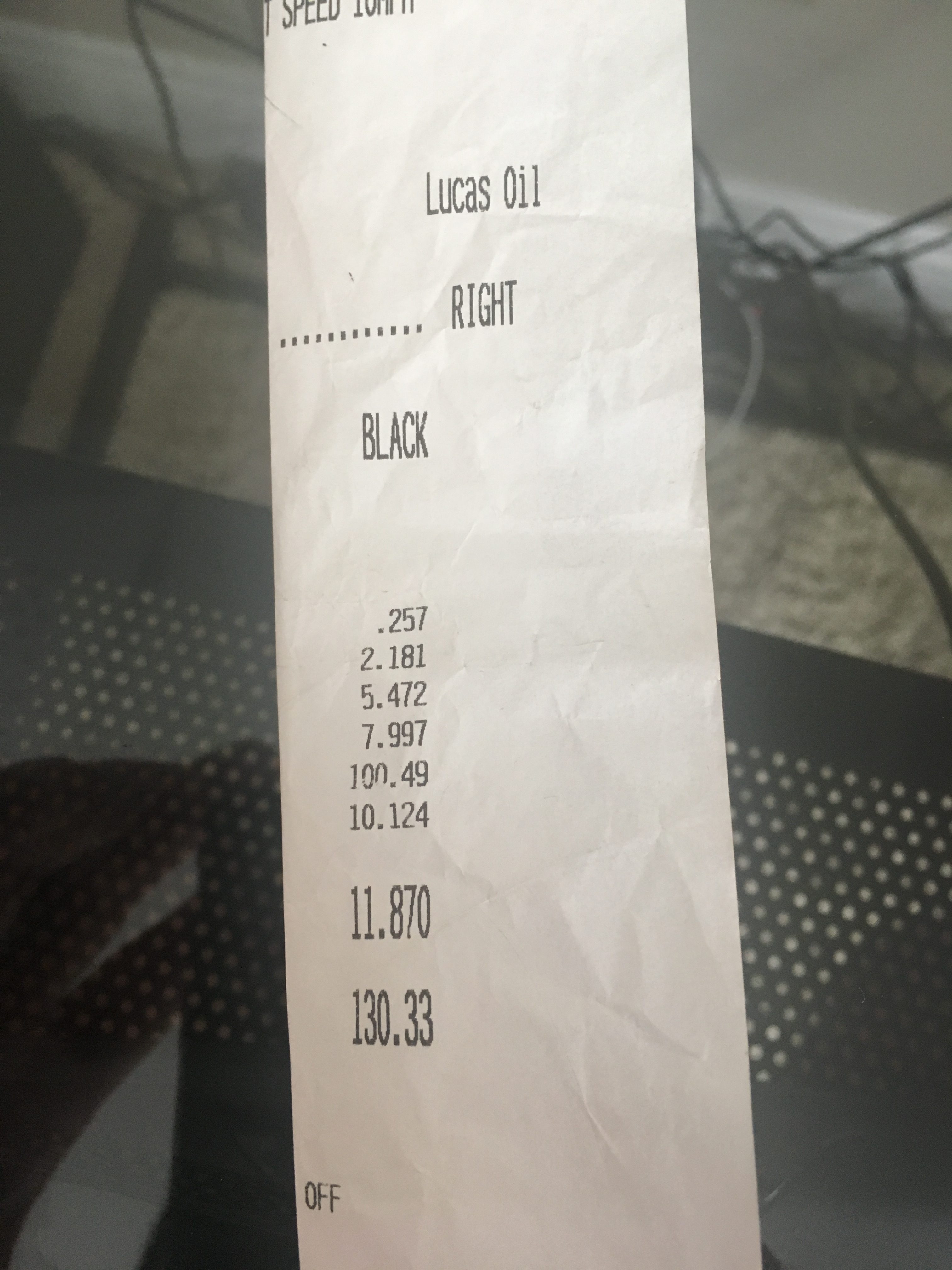
I had the misconception that 10s would be super easy to achieve on a Hayabusa. That was not the case for a rookie like me. There was a lot to learn and I was just beginning.
The good news is I went straight and had a ton of fun. I was hooked on the challenge.
It gave me even more respect for the racers who have mastered the sport.
Another takeaway I had after my first run is the importance of steering around the waterbox with the front tire. I found it can get very slippery burning out of the box and hard front braking with a wet front tire is never a good idea. Unfortunately many rookies have crashed coming out of the waterbox for the first time.
It was a busy night with Pro Mods in town, so I was only able to get one more pass and I went the wrong way. My ice cream cone melted again. I was distracted by the noise in the other lane, bogged off the line, again short-shifted and got smoked by a loud, classic Corvette. I ran 12.02 at 128 mph.
I was baffled at how to watch my tach and the tree at the same time. Once I couldn’t hear my bike over the Corvette I let my RPMs drop way too low.
It gave me a lot to think about on my dark ride back to Wrightsville, Pa., including how much easier it would be to be in a truck and trailer. But I was determined to stay true to my project. I was also determined to confer with some experts on how to best hone my skills and set up the bike a little better for the strip.
The damage was done. I was fully hooked and having a blast.
Drag Strip Visit No. 2 – Dragway 42, West Salem. Ohio, ManCup Fast by Gast Nationals, July 13 – 15, 2018 – Brock’s Performance Stage 1 Kit
I got a lot of great feedback on Facebook, and read and appreciated every word of it. Some racers suggested going with an ultra-long swingarm. It’s not bad advice to give a novice like me, but it’s not the way I wanted to go about this project. I wanted to learn with a difficult stock wheelbase application, and then I figured it would be easy to jump on something less challenging down the road.
I got a hold of Brock’s Performance – the essential first stop for any street bike racer looking to have some fun at the track. I told Brock of my slow debut runs. He avoided making fun of me and instead offered encouragement and told me how much his stage one kit helps racers with the same exact objective as me.
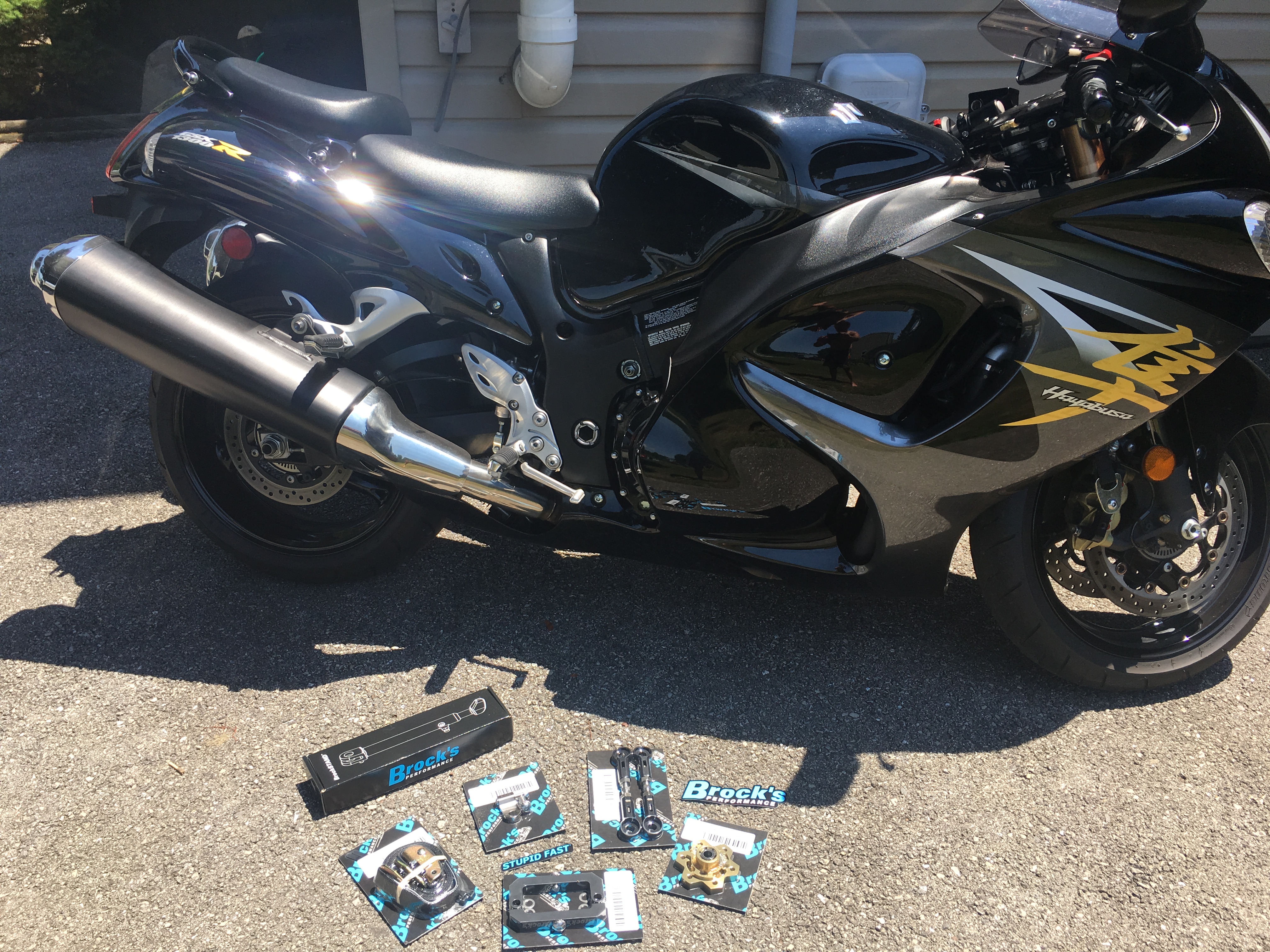
The stage one kit includes three components. Perhaps the most important is the Brock’s billet ultra-light clutch mod. Brock and others warned me beforehand, trying to drag race a Hayabusa without this clutch modification is not going to be much fun.
This mod replaces the factory back torque limiter and eliminates the bucking and chattering a rider will encounter with a stock setup. It makes for a much smoother operation. It’s made of billet 7075 aluminum. Along with improving ETs, Brock says it even prolongs the life of the clutch, chain and sprockets. I was excited to give it a try.
Also included in the stage one kit is a front end tie-down strap that connects to the front brake mounts. It gives a racer the ability to compress the front forks, to lower the center of gravity and prevent wheelies. This is another perfect part for my street – strip application because it can be easily taken off when it’s time to hit the road.
The final component in the stage one kit is the adjustable window lowering link. These beautiful CNC-machined, black anodized pieces help a rider drop down the back end to further lower the center of gravity.
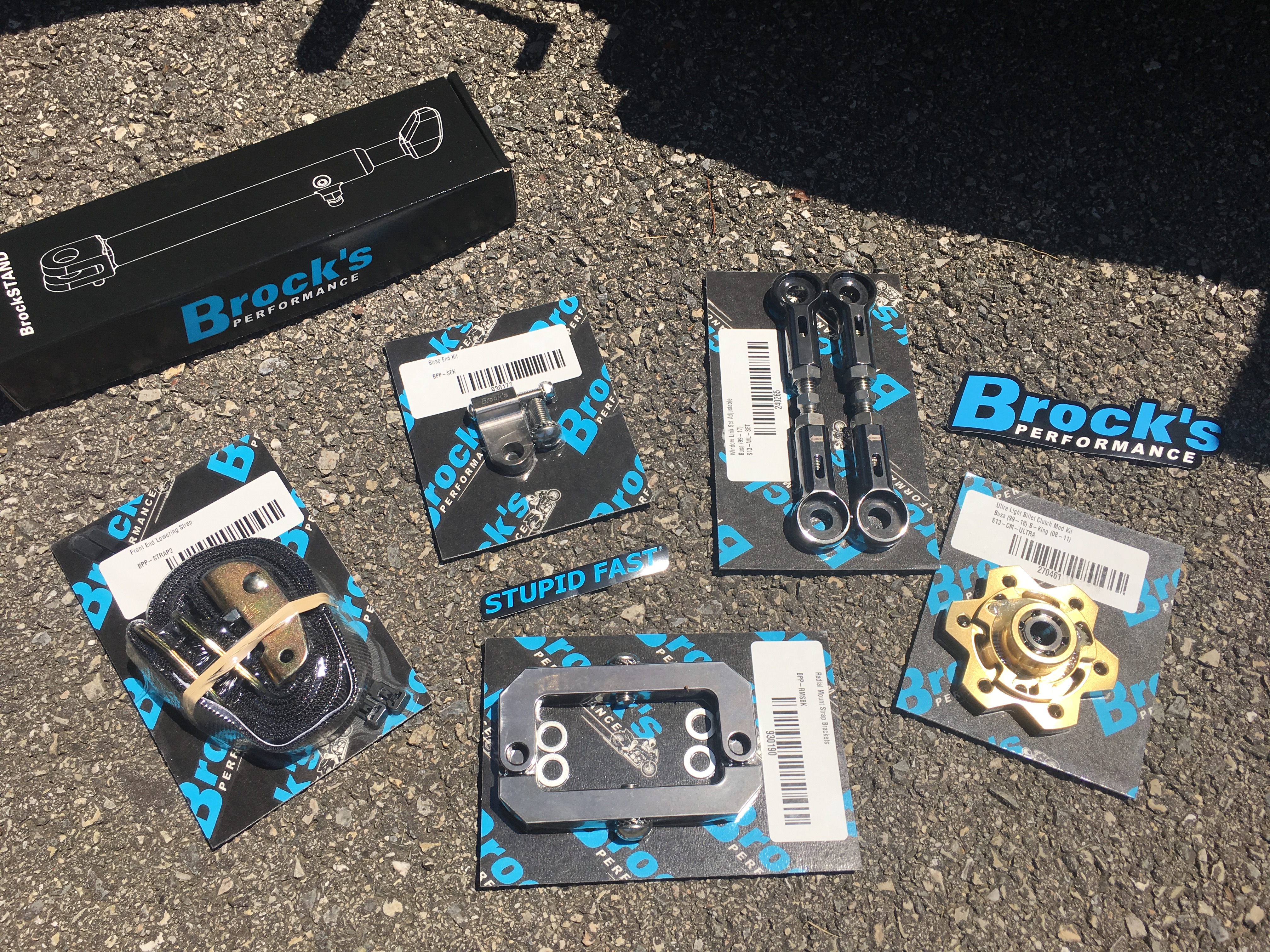
About a decade ago the great Richard Gadson ran 9.30s with a similar setup when the Gen 2 Hayabusa first came out. It was an astonishing feat.
It wasn’t a goal I had due to the fact that Richard is one of the greatest riders in the world. He’s also 140 pounds. My 190-pound rookie behind would be over the moon with a low 10.
Brock was closer to my weight class but is also an elite rider. He was able to run a 9.67 on the Hayabusa in this trim during his first trip to the track.
All of my pieces from Brock’s arrived just in time for my departure to the Man Cup Fast by Gast Nationals at Dragway 42 in West Salem, Ohio. I was excited to make the near 400-mile ride over to the Buckeye state for a weekend of covering the race on Cycledrag.com and hopefully improving on my Hayabusa.
A man who has been a great friend and mentor to me, “7.0” Joe Koenig, CEO of Trim-Tex Drywall Products made me a very generous offer. Along with being a great racer (he once held the Pro Stock Motorcycle world record at 7.029, hence the name “7.0”), Koenig is an excellent mechanic and he knew that along with learning how to race the Hayabusa, I also needed some guidance on how to work on it.

Koenig, who would be at the event racing multiple classes and supporting his Top Fuel team, told me he would help me put my new Brock’s components on during the weekend.
I met Joe at Gainesville Raceway when I announced my first ever AMA Prostar race back in November of 2001 and we hit it off right away. Koenig and his team were inviting and very helpful in educating me on what they do. Koenig has been a great supporter of motorcycle drag racing. He is the primary sponsor for the Spiderman and has backed several others throughout the years.
One such racer is Geno Scali, who along with Koenig, won the prestigious NHRA Pro Stock Motorcycle championship in 2003.
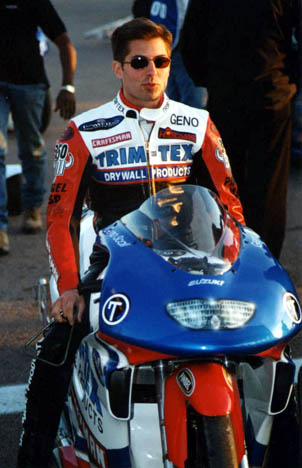
Like Koenig, Scali is a tremendous mechanic and an even better racer. Geno would be there with us at Dragway 42. I knew this would be a coveted opportunity to learn from a pair of skilled and accomplished pros.
On my ride in I encountered an issue on the road that reminded me this would be a different kind of challenge without a truck or trailer. A clamp on my front brake lever cracked. I was right at the halfway point between home and the dragstrip when it happened, so the best option was to find a Suzuki dealership nearby.
The clamp failure was due to the accidental removal of the stock piece by a friend who helped install a kill switch. I’m glad it happened because the reminder was one I needed. I would be the one out on the road on this thing with my life on the line so I had to take ownership and gain a better understanding of every component on the bike. Mechanical mistakes on a motorcycle can be devastating and I’ll be the first to admit I have made my share of mistakes wrenching over the years. As I modify this bike for drag racing I know it’s imperative that I triple check everything I need to be safe on the road.
I was about an hour away from Five Star Powersports in Duncansville, Pa., the same great place where I bought my motorcycle. Lead salesman and friend Scott Cobaugh really took care of me. He pulled the clamp I needed right off a bike on the showroom floor.
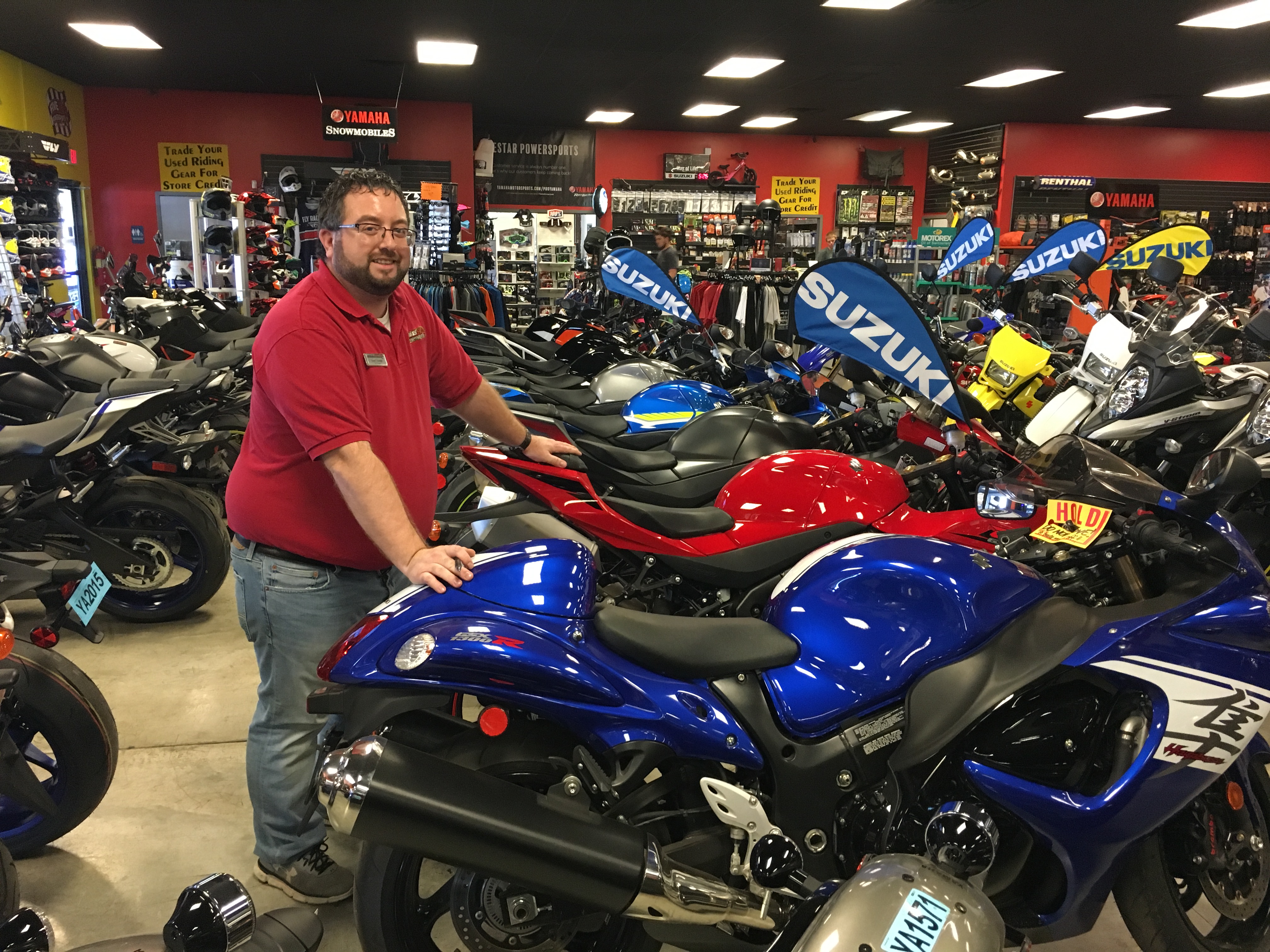
All-in-all I added about 120 miles and two hours to my trip, but I was not complaining. I was happy to have a well-secured front brake. I must be getting older and wiser. The younger me would have tried to make it to the track with the wobbly front brake clamp. The older version of me said why risk it? Plus I knew I wanted the correct component on during the weekend.
I pulled into Dragway 42 after dark and visited with Team McBride and Koenig. It was quickly off to bed because I knew I had a lot to accomplish throughout the long weekend.
The first order of business on Friday morning was to get a new front tire per the order of Joe. The tire was definitely at the end of its life after the long ride in. Tread was scarce and it was not fully smooth all the way across. Koenig stepped in and told me that was not a tire to go down the drag strip on.
I learned another lesson. What can get you by for a few more miles on the street may not be usable for high-speed drag racing. The motorcycle must be kept in excellent condition.
Geno and I found a dealership, Cycles R Us, about 15 miles away. I bought some new rubber and they were able to change and balance the tire in 45 minutes. It was certainly a worthwhile investment.
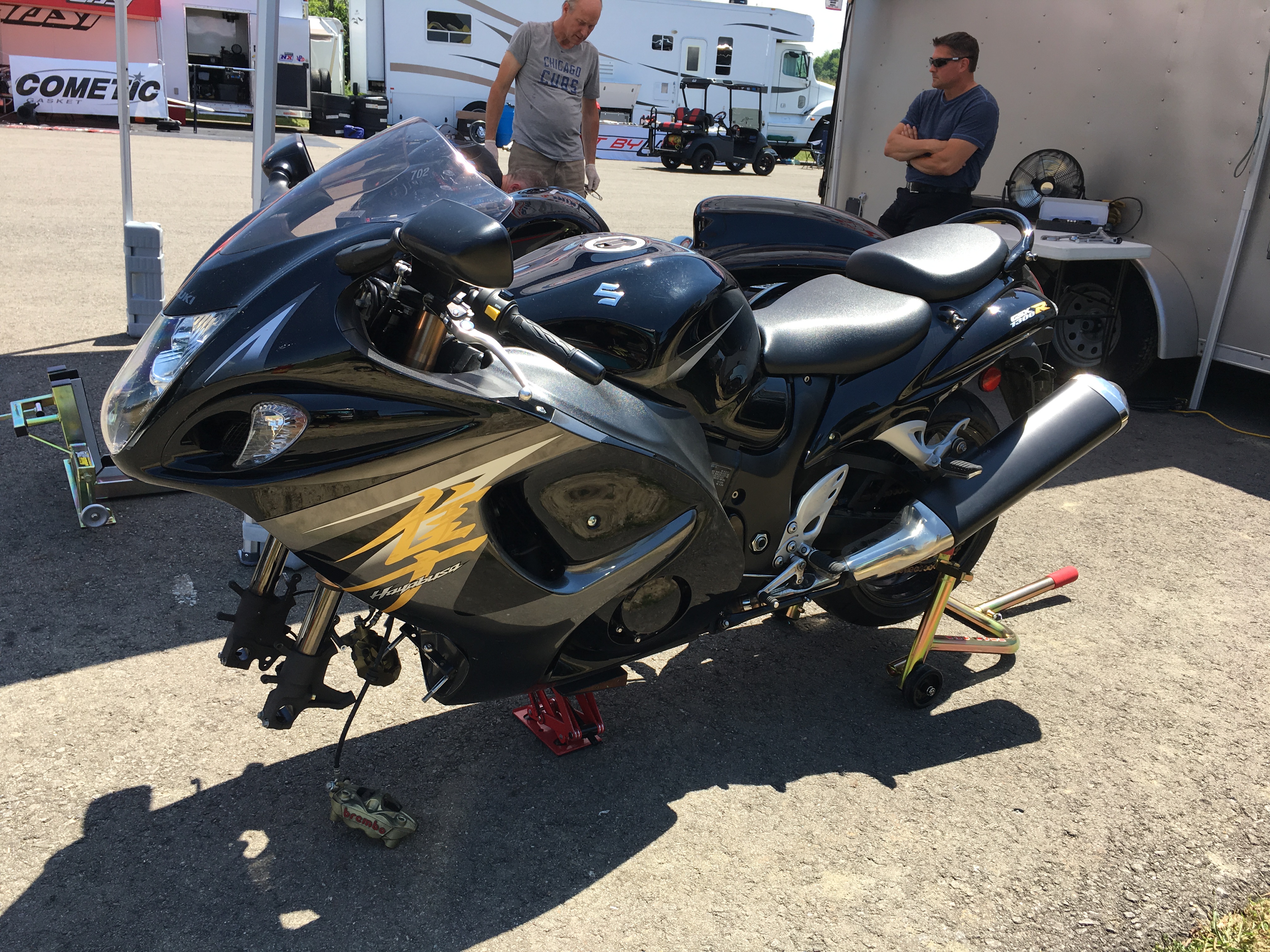
Koenig then showed us a trick to help unbind the front end. As you will see, he also showed great patience dealing with a man who is a better journalist than mechanic.
With the new rubber mounted it was now time to get to work installing the Brock’s stage one kit. I am amazed at how skilled Koenig and Scali are when it comes to working on a motorcycle. It’s something that has never come easy for me. I was not blessed with sound mechanical instincts, but I have found that with repetition, just like at the gym, I can improve.
I was trying to take as many mental and iPhone notes as I could. Along with installing the Brock’s parts, Koenig and Scali were giving me maintenance tips and things to stay on top of. It was a valuable session in Hayabusa maintenance school.
The parts from Brock’s came with easy-to-follow instructions and were not difficult to install.
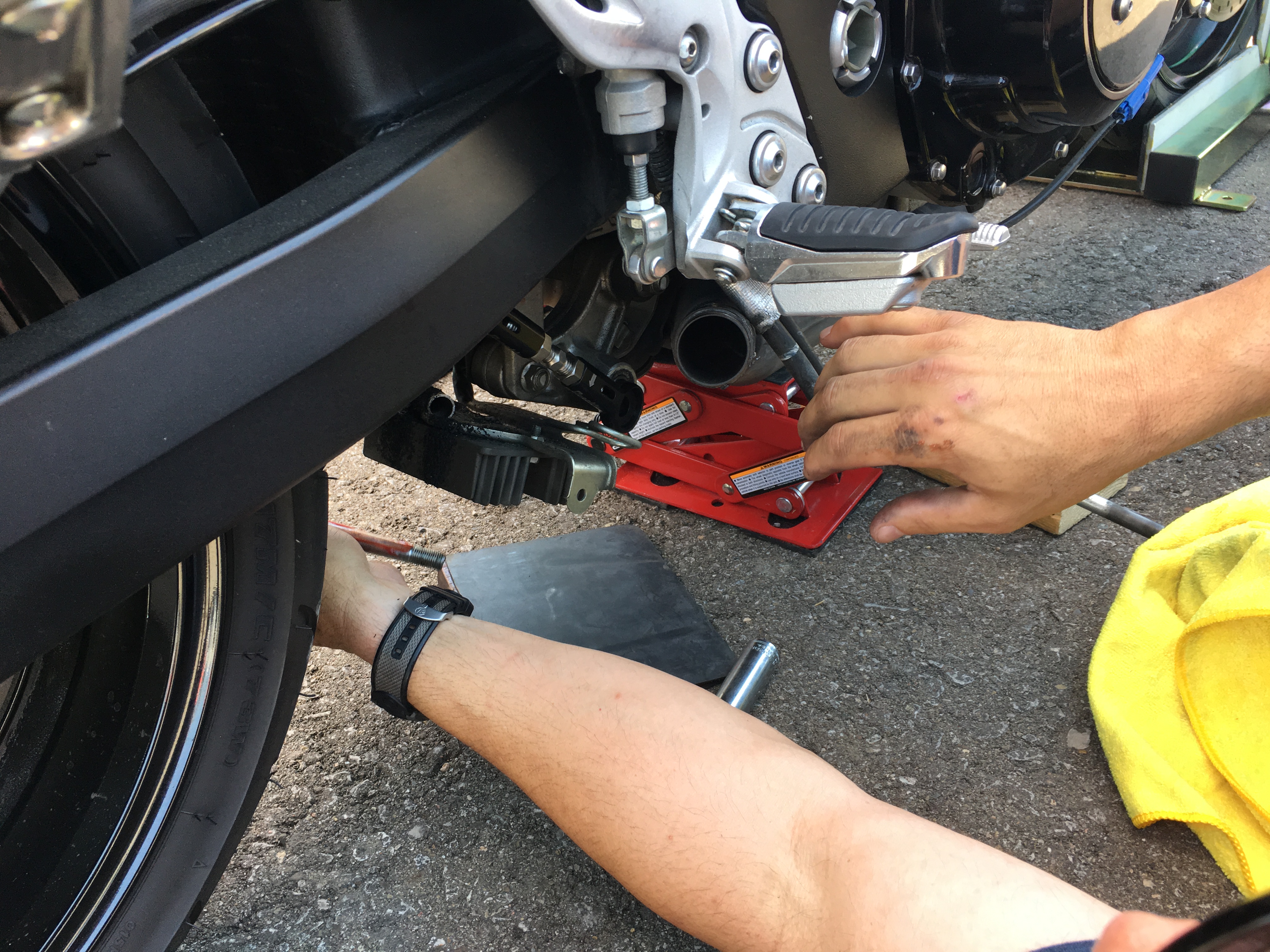
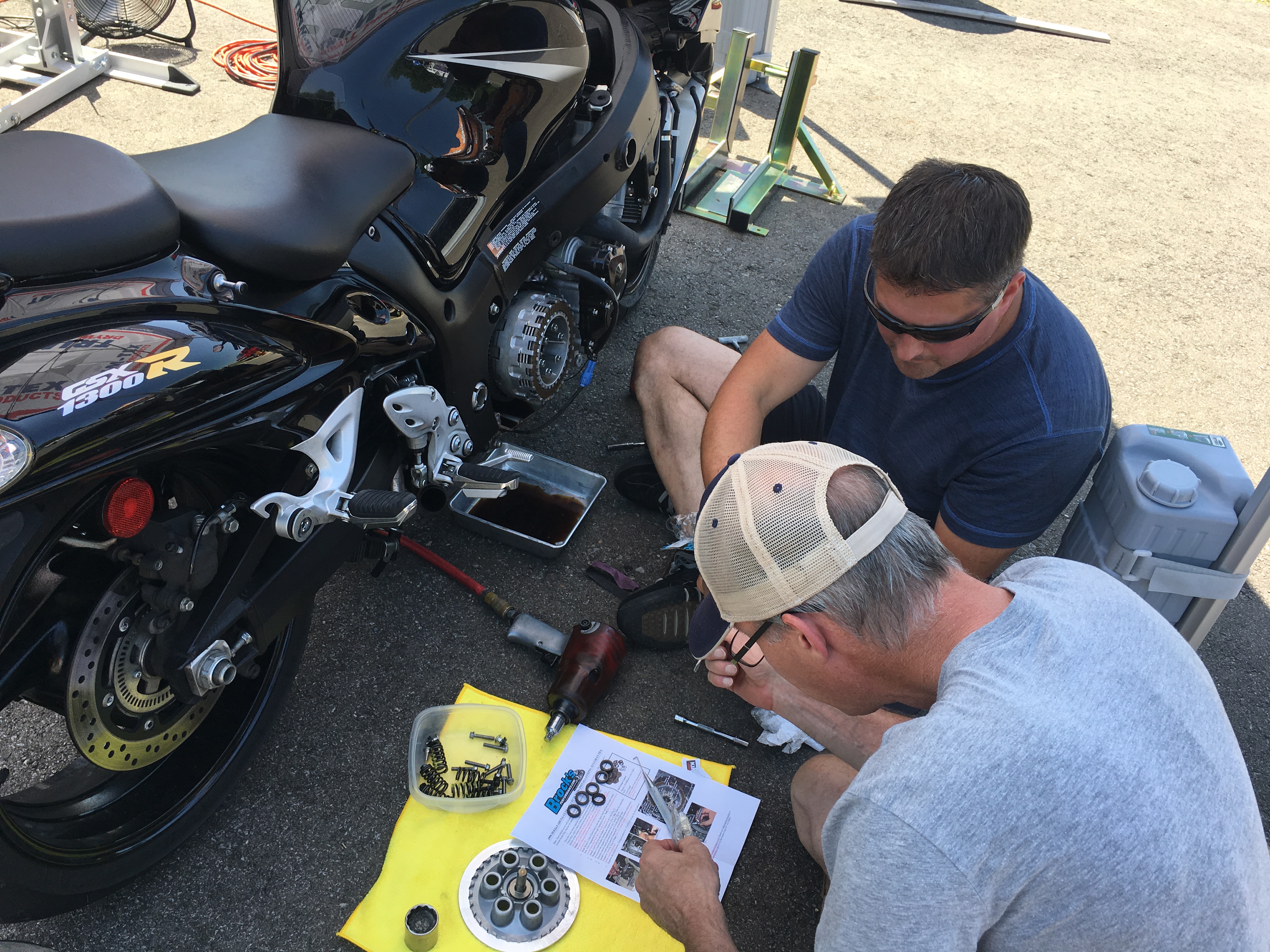
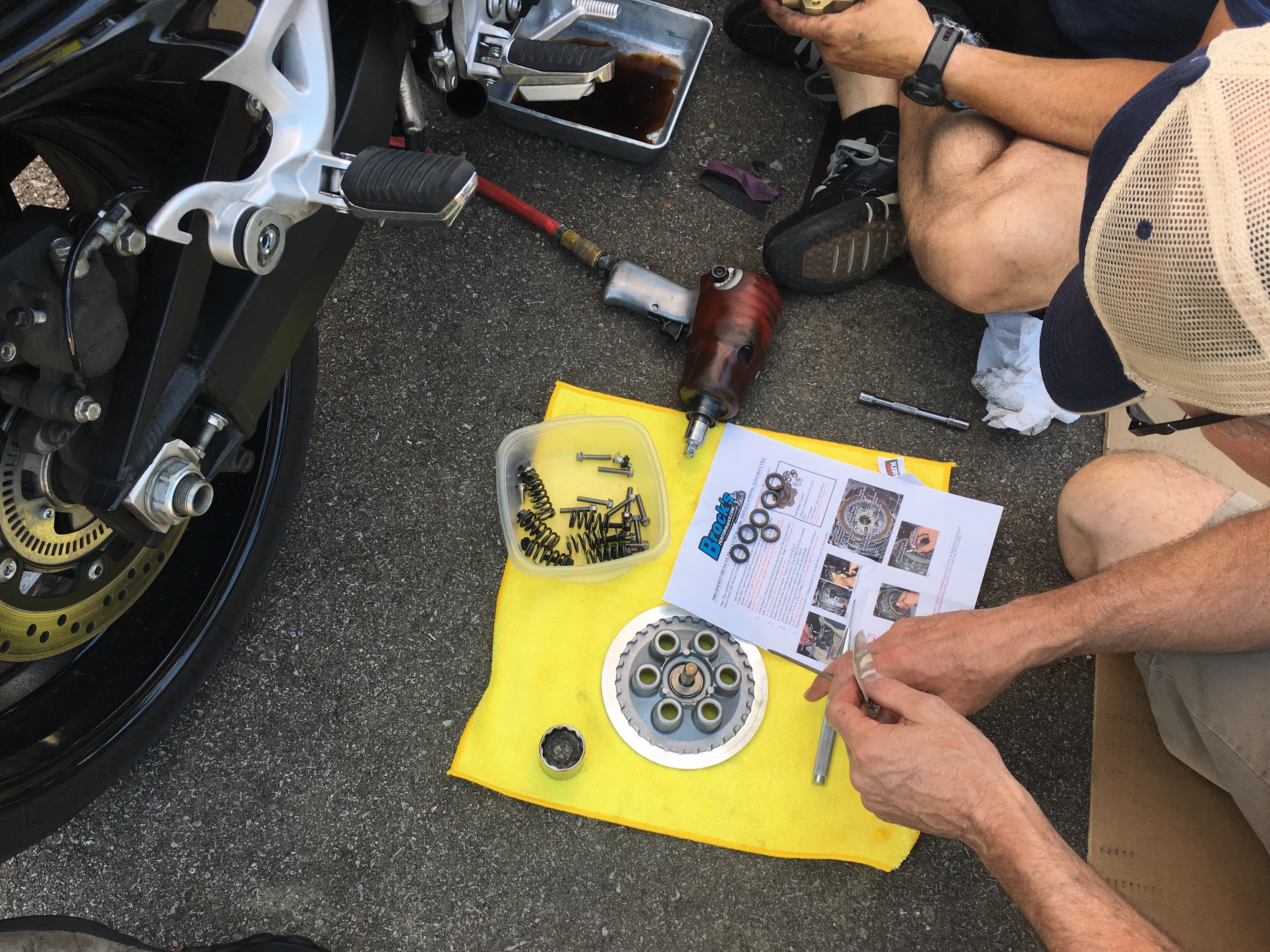
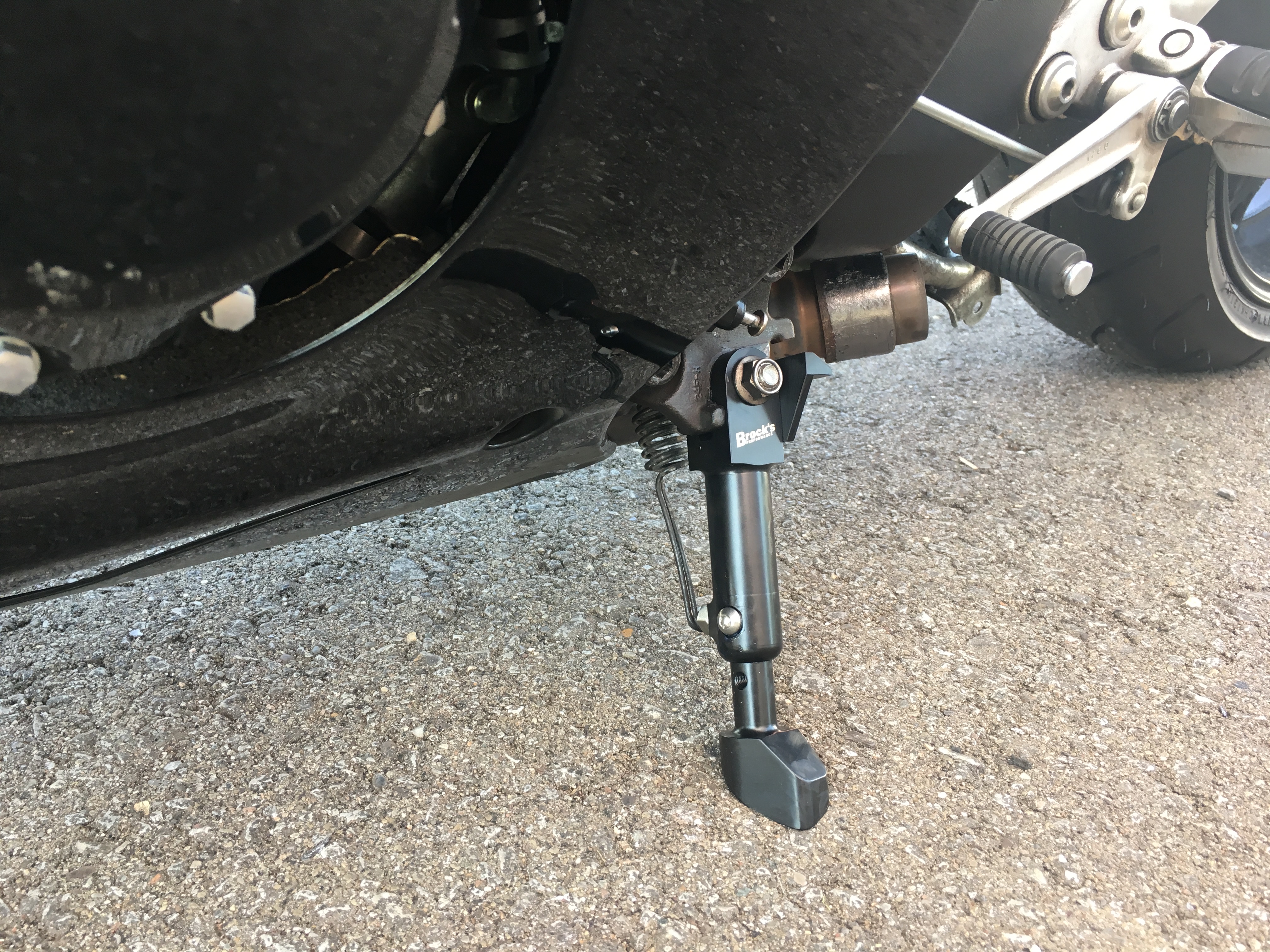
Even the great Spiderman came over to checkout our progress.
I was so fortunate to have these skilled mechanics helping me with the install.
After we were done, I could not believe how much the stance of the motorcycle had changed. I loved it. It suddenly looked a whole lot more like a dragbike than a road racer.
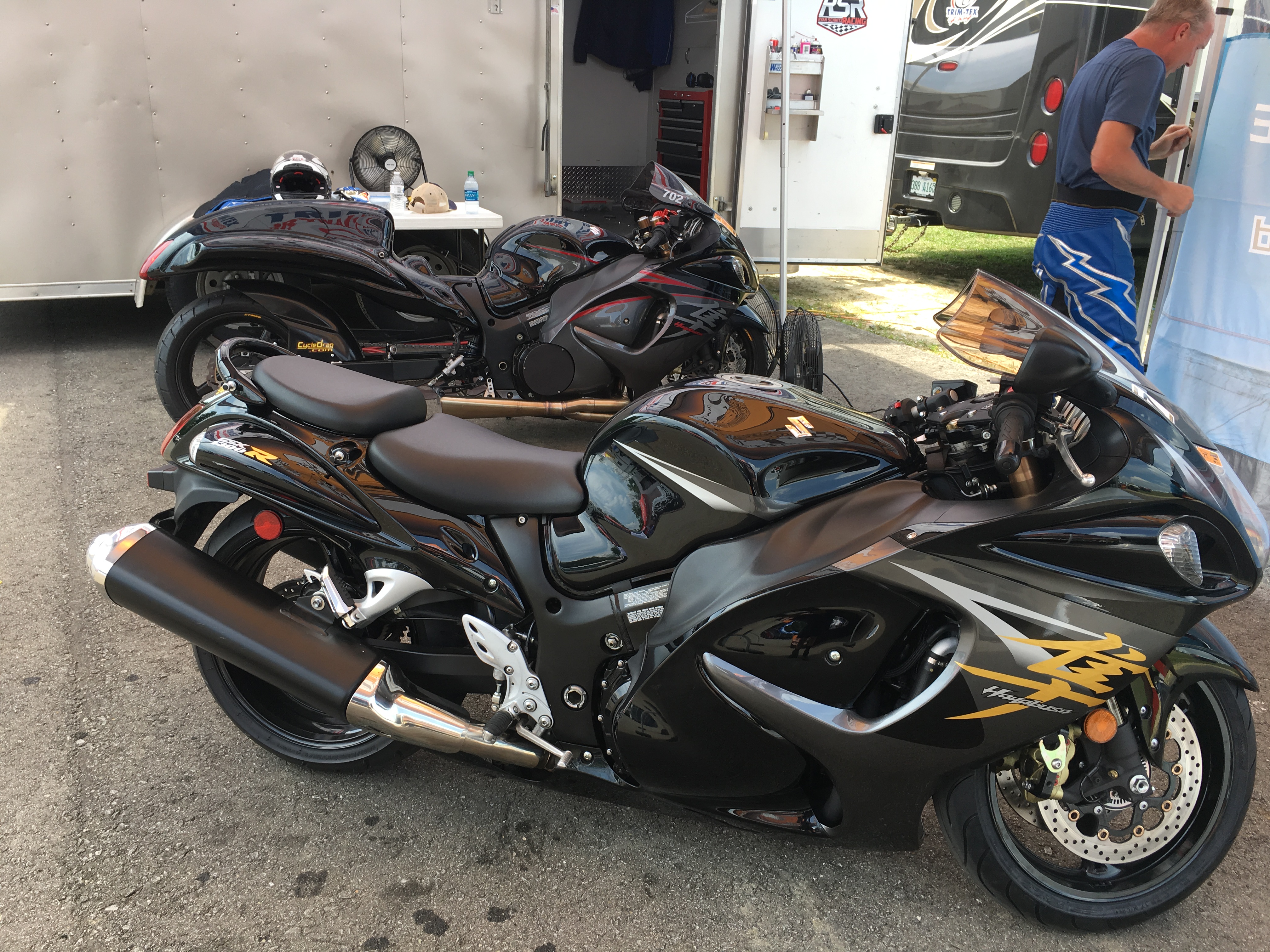
The new cool, low look of the Busa after the Brock stage one kit installation. In the background is Koenig’s Super Comp / Crazy 8s drag race-only Hayabusa.
I possessed so much nervous energy and excitement on Friday night I needed a double dose of melatonin to sleep.
Saturday morning brought some bad news for me as I found Man Cup would not be having an evening grudge session due to lack of participation. This is where I planned to make some practice laps. Instead Joe encouraged me to enter Street Fighter, the 9.50 -index class. I knew I was a long way from the desired 9.50 mark, but three qualifiers offered me the most track time to practice.
On my first pass, with sweaty palms, I rolled to an 11.05 at 134 mph. It was still slow as molasses by Hayabusa standards, but I was happy to have picked up almost a second on my third ever run.
It also quelled any fears about having the bike torn apart the day before. The new components felt great and I could sense Joe and Geno did a fantastic job in helping to give me a really safe motorcycle. With triple checks, and Geno and Joe looking over my shoulder, my Hayabusa was in prime shape for the track.
Geno and Joe offered some great advice on how to leave the starting line. They showed me how to lock the motorcycle in the desired RPM range before rolling from pre-stage to stage and how to keep it there when looking up at the tree. I also was fortunate to receive some advice and coaching from Jeremy Teasley, arguably the greatest no-bar racer in the sport, as I practiced some holeshots on the far end of the track.
On my next pass I tried my best to utilize all the information and tips I was given and attempted to bring my RPMs up to about 4,500. I wheelied off the line, let off, got back in it and still picked up to a 10.60 at 135 mph. After I came back from the run Geno told me I let the clutch out too quickly. I was so focused on locking in my RPMs I suddenly forgot about the other hand and just dumped the clutch. What a challenge this sport is.
For my final pass of the day I wanted to focus on trying to hold the RPMS in the right spot, hopefully a little closer to 5,000, while doing a better job slipping the clutch. I also wanted to focus on not shifting the motorcycle until the redline. After a talk with Teasley I determined I had still been short-shifting my bike all along in fear of hurting it.
“These things are durable,” Teasley said. “Let it hit the redline.”
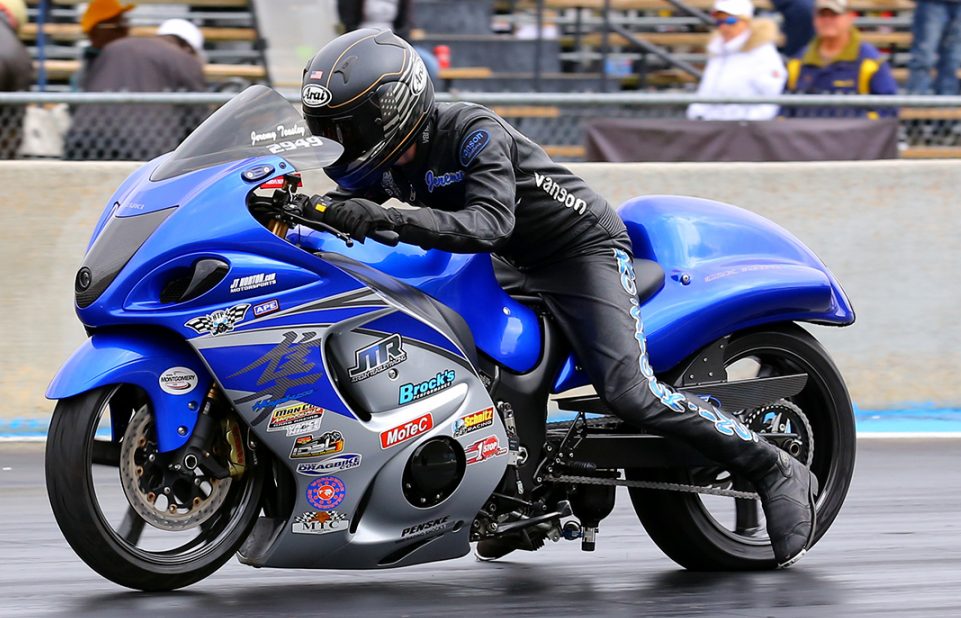
Coming from him, a man who has probably made 10,000 or more passes on a Hayabusa, I knew it was sound advice.
I left with a 1.73 60-foot time and ran my best ever, a 10.33 at 138 mph. I was still moving at a lethargic pace by Busa standards, a full second behind what Richard was able to do, but for my fifth ever pass on the bike I was very happy. I was also thoroughly hooked.
I was reminded of what someone warned one time about giving golf a try.
“If you ever pick up a club, you will never put it down,” I was told.
Fortunately for those who would be punished golfing with me, I didn’t pick up a club for long, but I did understand the message. Golf is such a mental challenge, it’s addicting. I felt the exact same way about learning to drag race this high-horsepower, stock wheelbase bike. It would be a game of finesse.
I recognized the substantial amount of practice time it would take to learn to leave correctly and consistently.
I discovered the slim margin for error on the line; not enough gas and I would bog, too much gas or too quick with the clutch and I would wheelie. I had to hit it just right.
The next day, I learned another great lesson about getting overly excited or aggressive during first round of eliminations against my friend and hardcore nationwide dragbike racer Barry Pryer. By the way, how did Pryer get so lucky to land me in round one? He was well aware I was just starting out and was a country mile from the 9.50 index.
“C’mon, turn on the red one for me,” I joked with him. “Hell no,” laughed Pryer.
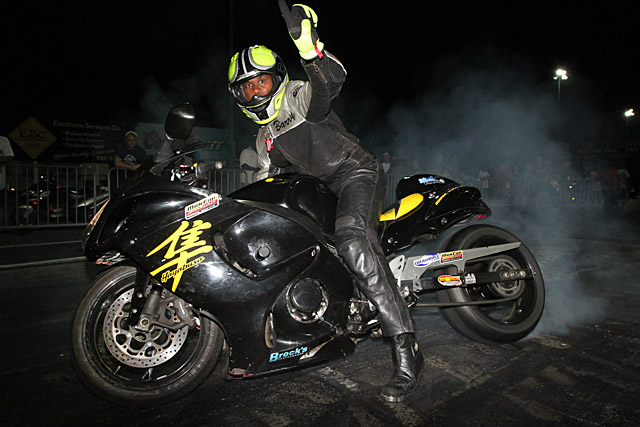
I knew it would almost certainly be my final run of the weekend so I tried as hard as I could to improve on my 10.33. The result was an overzealous, clutch-dumping launch that resulted in a wheelie and a slower 10.48. I did pick up to my highest speed at 139 mph. I think the increase in mph was due to the tip Teasley gave me to not use the clutch. Boy that sounds scary when you are used to riding on the street, but Teasley told me to just kill the throttle and quickly shift it up. It worked well and I was able to get a little more of fourth gear through the finish line. I also tried to tuck a little tighter per the advice of Geno.
I sent Brock my time tickets and he gave me a great piece of feedback. He could tell I did not have my throttle locked before the one-two shift by my off-pace 330 times in the 4.7 to 4.6 range. I’ve often heard Rickey Gadson and others talk about how 330′ is everything in sport bike drag racing. It now made perfect sense to me. I feel like all the finesse comes in early on. Once past the eighth it’s fun and easy – tuck hard, shift on time and keep it pinned!
I did not leave with a nine-second time ticket but I could not have had a better time. I was so thankful for all the advice and help from everyone, especially Geno and Joe, who caught me on video right after the first round of eliminations.
After the race came another important diagnoses of the parts. It was time to begin the long trip back home.
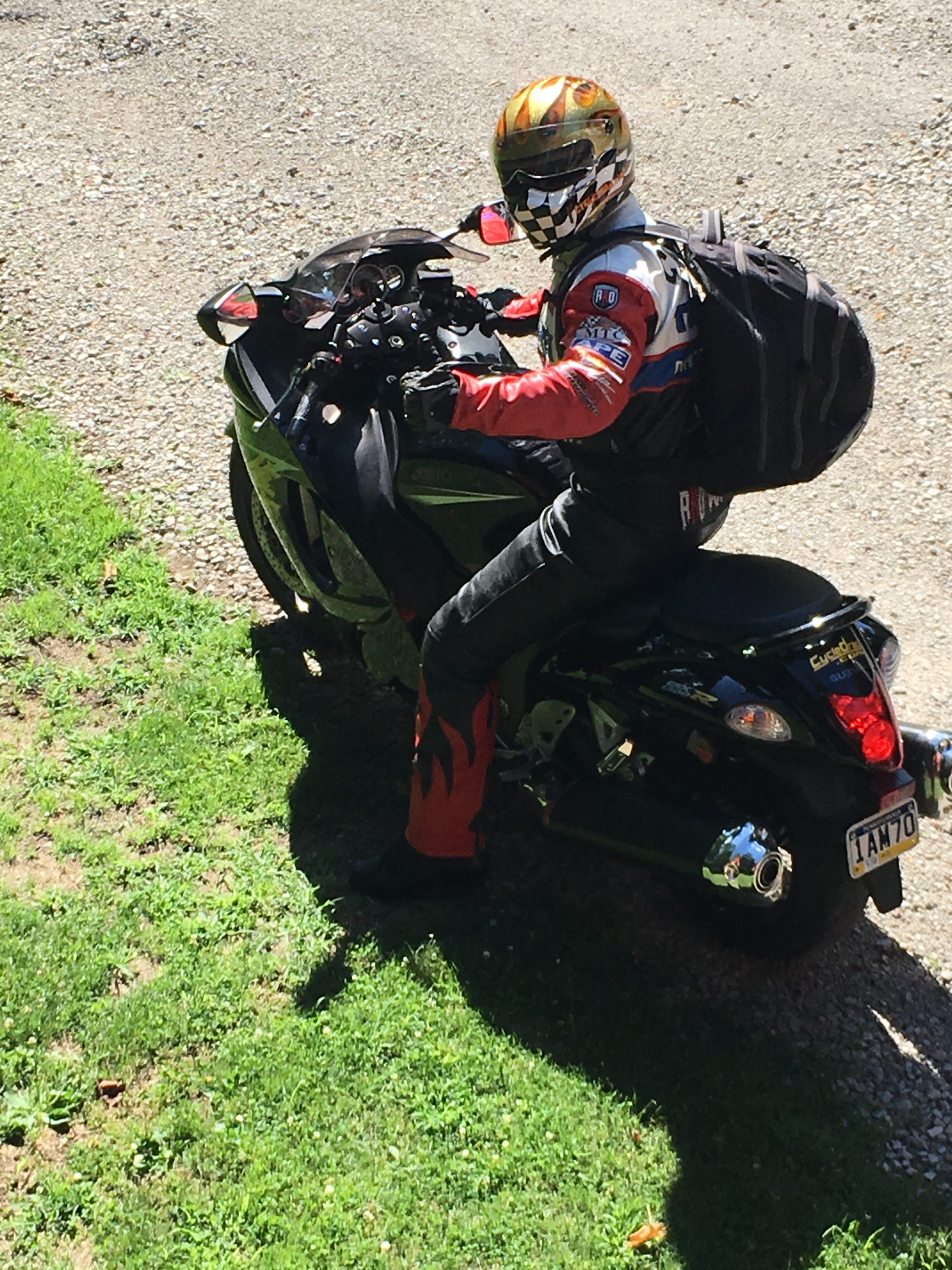
I brought the air pressure in the rear tire back up to the recommended 42 psi from the 25 psi we used to race, removed the front strap and loaded my massive bookbag. I triple checked everything I had tampered with. I knew going out on the Ohio and Pennsylvania Turnpikes would be more dangerous than anything I did on the drag strip. I was concerned that we may have drastically changed the bike’s characteristics and handling for the street.
As I began my ride all of my fears subsided. Aside from a little bit of a stiffer clutch lever I could not tell much difference. Despite the lower rear end the handling on the bike still felt great. In fact it was even more stable on the straights and I felt I had better control of the bike when it was stopped since I no longer had to be on my tippy toes.
I may have lost just a tad in extreme cornering ability but that won’t bother me at all. The Hayabusa is a big heavy bike and I don’t plan on doing any knee-dragging out on the street. I hit some pretty large-sized potholes and cracks on the way home and the suspension still performed flawlessly. All I had to watch for now was crossing over massive speed bumps in parking lots.
I was very satisfied and felt totally safe with the stage one kit on the street. Brock is not just a racer, he’s a street rider, and clearly took all of these factors into consideration when developing these amazing parts.
And again I can’t say enough about the cool stance! It looks like a dragbike! Not a canyon climber.
Considering the air was pretty miserable in Ohio at about 5,000 feet of corrected altitude and the long way I have to go as a rider, I’d be very happy if I could get this machine in the nine-second zone as-is.
Drag Strip Visit No. 3- Maryland International Raceway, XDA WPGC Bike Fest, July 27-29, 2018
After the Ohio marathon ride, the short 150-mile trip down to Maryland International Raceway for what is always one of the biggest races of the year was unavoidable. I knew my way without a GPS, having announced at this track since 2002 as well as serving as the IDBL promoter for the previous two seasons . It’s always fun to make the scenic ride down.
I arrived on Saturday and focused on covering McBride and Dave Vantine. On Sunday I entered Grudge to get some more seat time in hopes of improving on my 10.33
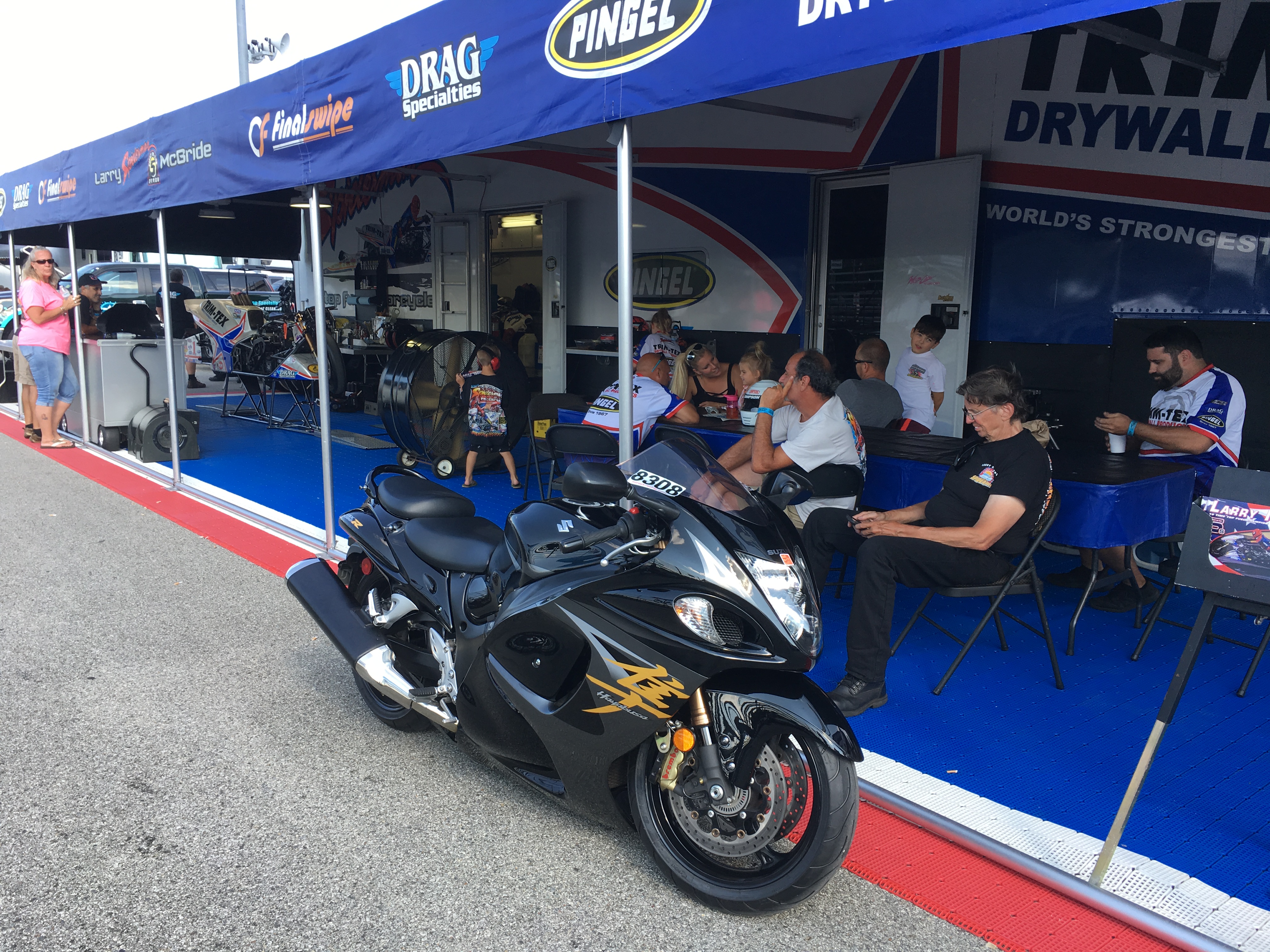
Again I was humbled at how much there is to learn in this sport. I figured I’d pick up right where I left off in Ohio. I was wrong.
My first pass was a 10.57 at 138 mph followed by a 10.59 at 139 mph. I had lost ground on my sixty-foots. MDIR is known for a very tacky and thorough track prep. It was very different from what I raced on at Dragway 42 and Maple Grove. I can see why the Pro Street and grudge guys love it, but for my stock, street-tire bike I had no business being in the stickiest grove.
The extra bite changed my leave quite a bit. I talked to Brock and he told me to bump my tire pressure up to around 32 psi from the 25 I was running.
On my third pass I lined up outside of the groove and tried to focus on getting the throttle locked quicker. It resulted in one of my best 330′ times with a 4.57 but the run went awry when I could not get my foot up to make the shift into second gear in time. I was so focused on trying to leave the line quicker I got lazy with my left leg.
I knew the fourth run would be my last and I was really hoping to leave MDIR with a personal best. I hit a 4.59 330′, got the shift this time and picked up to a 10.29 at 140 mph.
Looking at the video I can see I’m leaving a lot of ET on the table with my launch. I’m hoping I can figure out how to get out of the hole quicker.
Above all, I again had a lot of fun and was very happy with my 10.29 at 140 mph on only my 10th ever pass on the bike.
I went back to the pits, removed the strap, pumped the rear tire back up to 42 psi and began the ride home through Washington, D.C. Figuring out what I needed to do to get into the nines was on my mind for much of the trip home. I was eager for another shot.
The goal is to get my 330′ times in the 4.2 range and the rest should take care of itself. I told myself, it’s all about getting the clutch out smoothly, getting the throttle locked and avoiding the big wheelies.
Drag Strip Visit No. 4 – Cecil County Dragway, Rising Sun, Md. – Wednesday Test N’ Tune, August 8th, 2018 – A chat with the master and an unexpected flood
I knew my fourth trip to the strip would net me what I was after, maximum seat time. As I did some research I was amazed at how many less-than-famous dragstrips were in riding distance for me. Cecil County Dragway, which I had only been to once in 2006 to announce a Harley race, was only 58 miles away and a perfect choice. I knew I’d get a lot of runs in the 6 pm to 10 pm weekday session.
Before I left for the track I had spent a lot of time watching the videos of my previous runs and listening carefully to the advice of experts. I discovered another great aspect of this sport. Everyone seems to have their own technique that works for them. There wasn’t a universal riding style.
Since the advice I was receiving varied so widely I decided to send my videos down to the teacher himself to see what he thought. One of the greatest riders in the world and instructor of his own drag racing school, Rickey Gadson has coached hundreds of riders of all different ability levels. I had been watching Gadson since I was a kid. He is a multi-time champion and the first motorcycle drag racer to secure a full factory deal.
He’s currently a host on the Caffeine and Octane show on NBC Sports Network. He’s a first ballot Hall of Famer in our sport for sure.
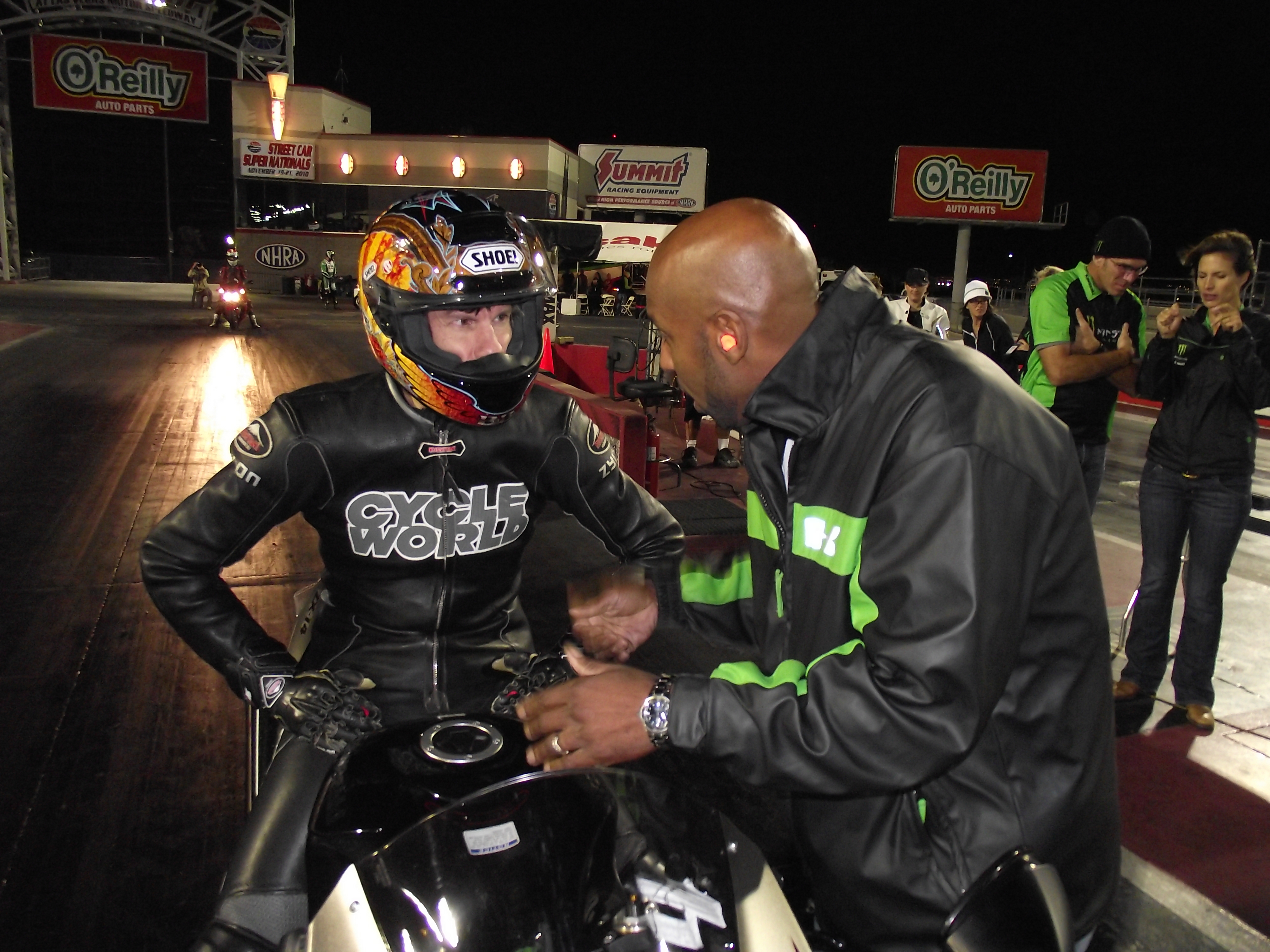
After watching my videos, Gadson’s first suggestion was to attend his school, which I plan to do. Through his analysis he determined I was “walking out” the clutch slowly and then pinning the gas. Gadson stressed the importance of throttle – clutch management and how the two had to work in unison with every reaction happening simultaneously on each hand. For every percentage I let the clutch out I had to meet it with the appropriate percentage of throttle twist. A few riders have told me they like to go full throttle immediately and then control it with the clutch. Gadson said that was not his approach. I could tell this was something that would take a while to perfect.
I was excited to practice so I loaded up my bookbag and left the house at around 3 pm to get to the track nice and early. It was a beautiful sunny day, but the past two weeks had been absolutely waterlogged, as Central Pa., experienced some significant flooding.
My mind was consumed with improving my launch at the drag strip. I was not at all expecting what I encountered on back farm roads in the heart of Amish county in Lancaster County on the way to the track.
Having just had Lasik surgery, my eyesight was much better than usual, and as I approached what looked like a giant puddle, I slightly cringed because I had spent so much time shining up my motorcycle. As I got closer and watched a van in front of me hit the water, I realized this was not a puddle, this was some seriously deep and fast-moving runoff from an overflowing creek parallel to the road.
I felt more like I was on my dirt bike assessing a creek crossing. Just like in woods riding the first thing I did was scan the area to see if there was another way around. Traffic was coming behind me and I did not want to take any chances going off-road with the Busa and ending up in a muddy ditch without a knobby. I also had no idea where I was as I was listening to my GPS in my ear. I decided to go for it, hoping the water was not deep enough to do any damage to my motorcycle’s bearings. I made it through cleanly but my bike was a mess.
I laughed to myself at the challenge created with this street – strip project. I’m certain not too many of today’s drag racers cross creeks with their bikes before getting to the track, but heck it makes for a cool story.
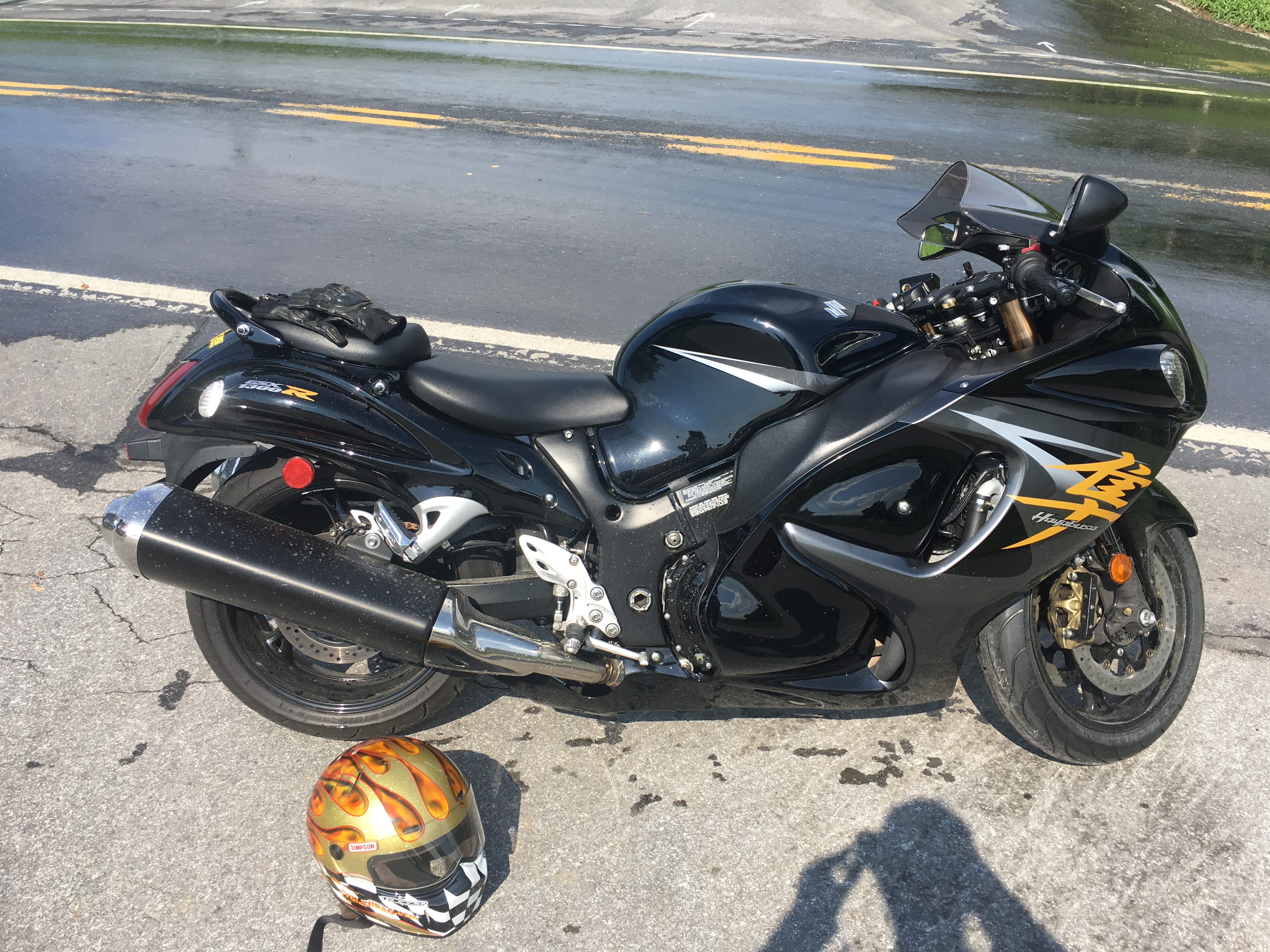
The Busa was a little wet and dirty but that certainly wasn’t going to stop me from making my way to Cecil County.
I rolled through the gate and could tell right away it was going to be a fun night. It was not overly crowded. It was another pure grassroots drag racing kind of evening.
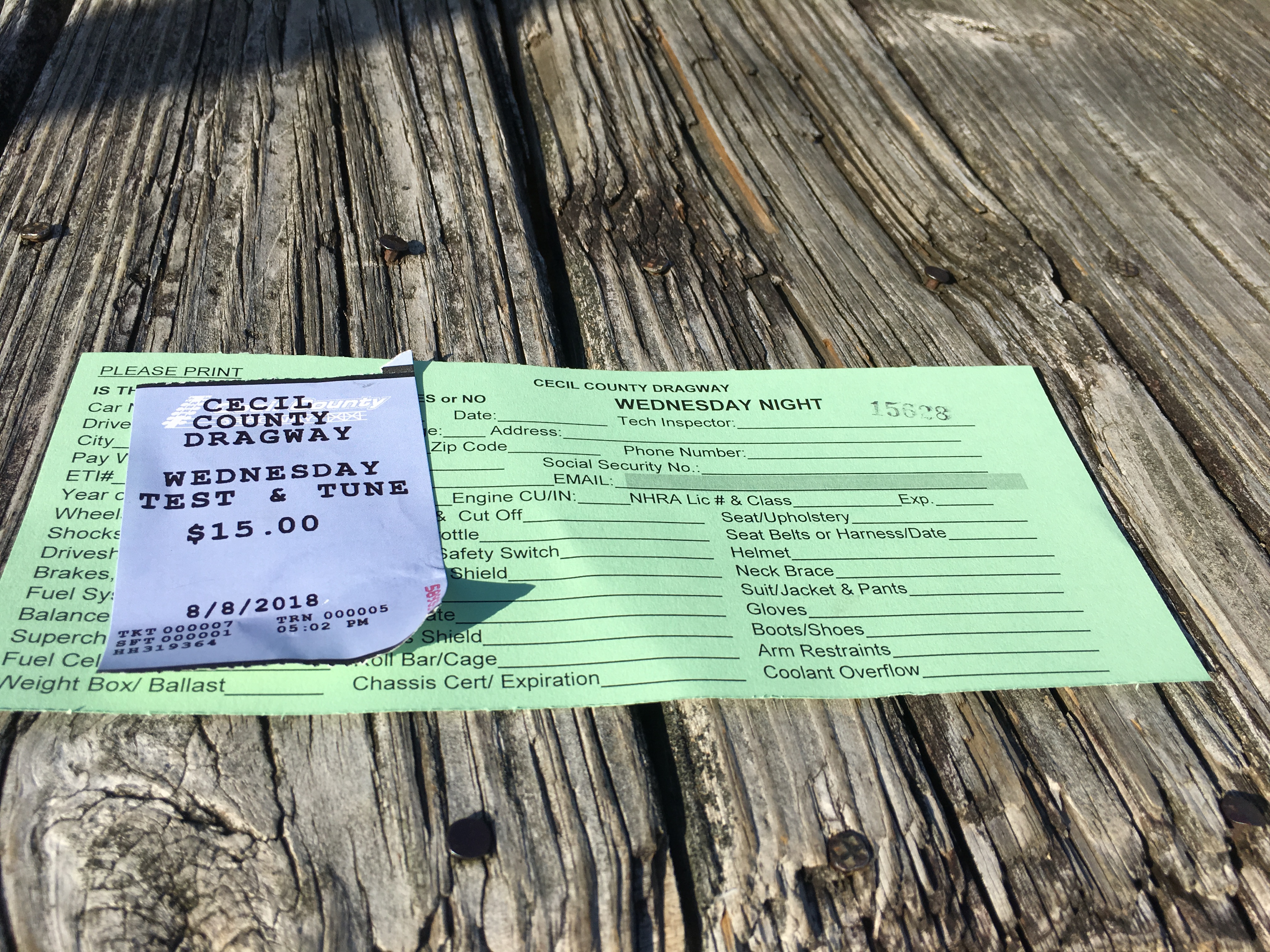
Gadson was very excited to help me, something I appreciated greatly. He told me to call him as soon as I got to the track.
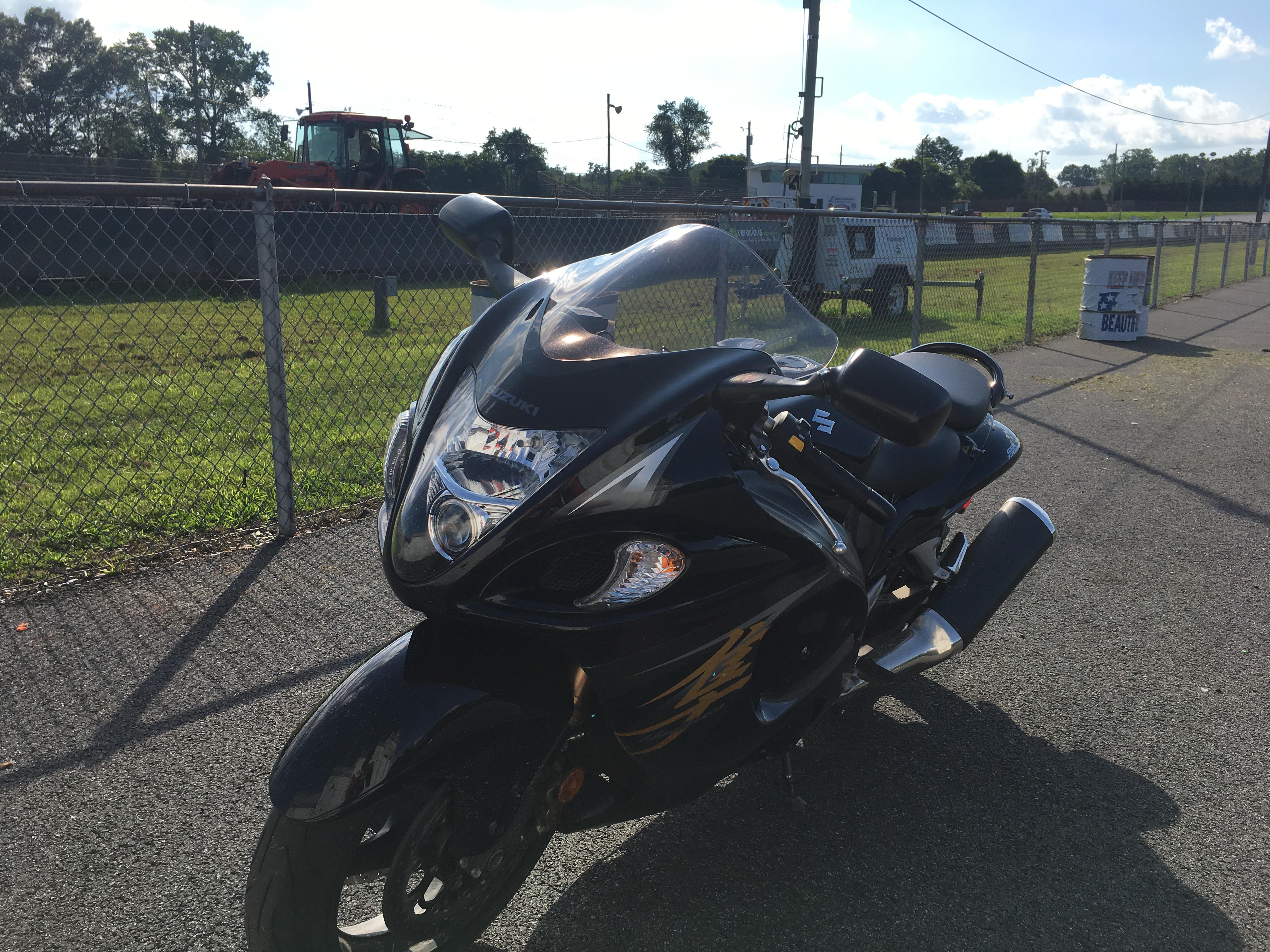
Gadson advised me to lower my launch RPMs down to 3,500. He told me with the amount of torque the Hayabusa has, it’s not necessary to leave at high RPMs. While coaching over the phone he had me hold the bike at 3,500 RPMs while sitting in the pits to get used to the sound it makes.
He also stressed the importance of leaving with the clutch lever at the very beginning of the friction zone.
I made my way to the lanes and I could tell right away this night would be just how I envisioned it with as much track time as I wanted. Without a truck and trailer, my concern now shifted to how many runs is too many? I didn’t want to toast my clutch or completely ruin my back tire.
Gadson told me the stock Hayabusa can easily make three consecutive laps without overheating. He told me back-to-back runs are great for someone who is learning because a mistake can be quickly corrected while still fresh in the mind. I was making three runs and then giving my bike 30-45 minutes to cool down. I was also trying to go easy, and do just enough on my burnout to clean off and warm up the tire. I figured there was no reason to put on a John Force display and turn my tire to charcoal.
The night was as frustrating as it was fun. I was again reminded of how this sport is a game of sharp shooting and precision. I had a very difficult time repeating a good run. But with each mistake I learned a new lesson.
On my fifth pass of the night, my 17th ever, I ran my career best with a 10.24 at 140.55 mph.
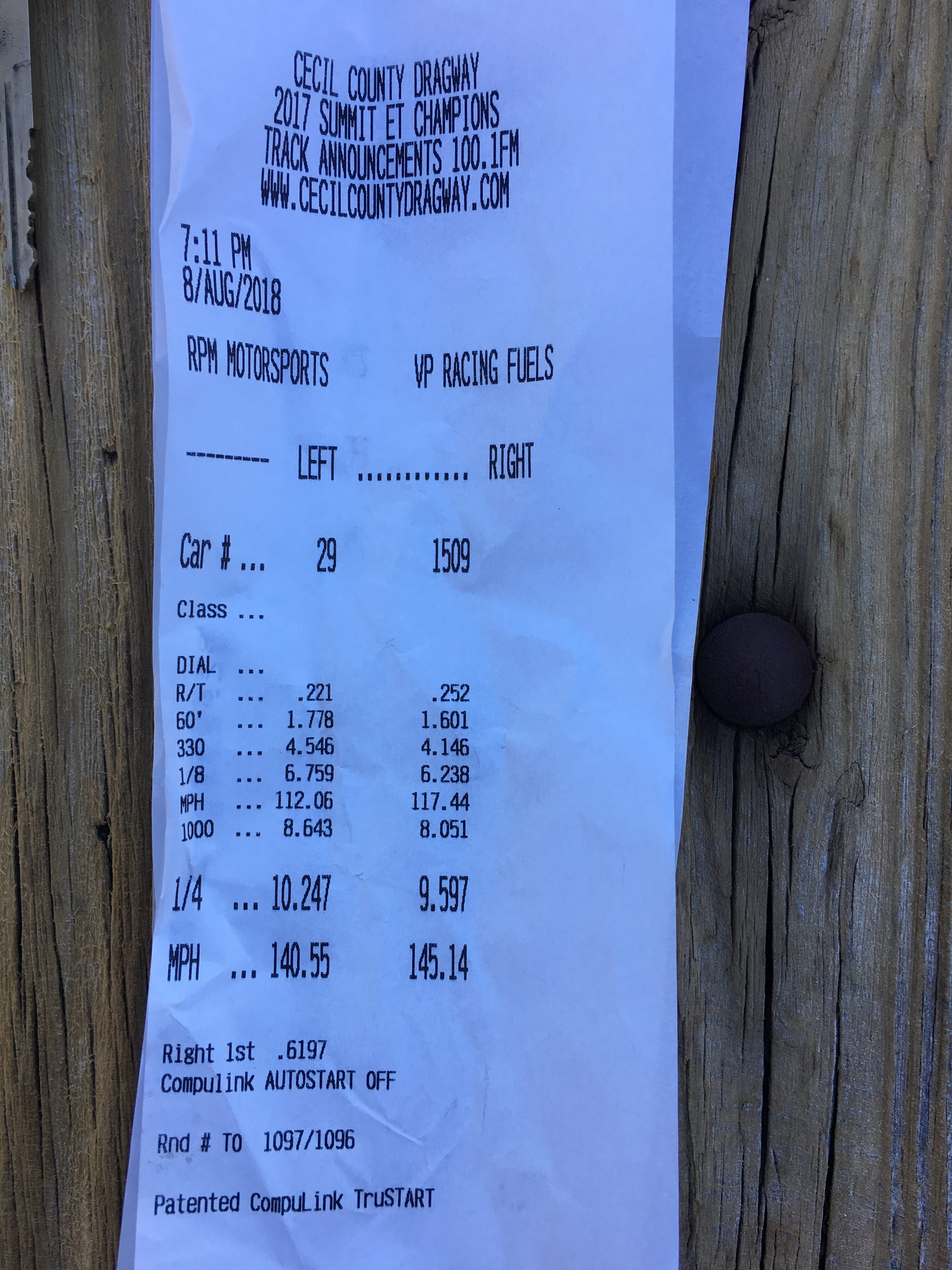
I was upset with myself because I felt like I would sit on my picnic table pit area near the concession stand and visualize how I would come off harder, be smoother and quicker with the clutch and get my throttle locked sooner, only to not change a damn thing once I got up to the line. I could see I was hitting a bit of a plateau and falling into a comfort zone.
I was also using the clutch to shift despite telling myself not to. That’s a habit that will take a while to break.
From this video, experienced street racer Chris Johnsen pointed out on Facebook how I am brigning my feet up too quickly and suggested I use leave them down to use them as wheelie bars instead. Gadson chimed in and added that if I was leaving harder I would not be able to bring my feet up so quickly because of the force from the hard acceleration. I knew either way I needed to be in position to make that shift into second.
After reviewing the film, I realized that maybe subconsciously my style comes from years of watching wheelie bar racing, where racers aim to get their feet up on the pegs as soon as possible. Racing a stock wheelbase Hayabusa would require a much different technique.
I recognize that I need to get comfortable with a harder, quicker and more forceful launch. It’s a motion I imagine will, at least slightly, set the front wheel off the ground. I know the new motion will require additional seat time to get comfortable with. In all my years of motorcycling, on the dirt or elsewhere, I’ve never enjoyed or felt real comfortable riding wheelies and I’m sure that’s one of my limitations here. I marvel when I see guys like Gadson put the front wheel up and go 120 mph. I’ve never liked the front wheel in the air on the Hayabusa. As cool as it looks, I just feel like I’m asking for trouble. I’m hoping as I learn this new launch I will get more comfortable with a modest wheelie and learn how to control it.
Although I did not capture my much-sought-after first nine-second time slip, I’m very pleased with the progress I’ve made from my first to my fourth trip to the drag strip on my Hayabusa.
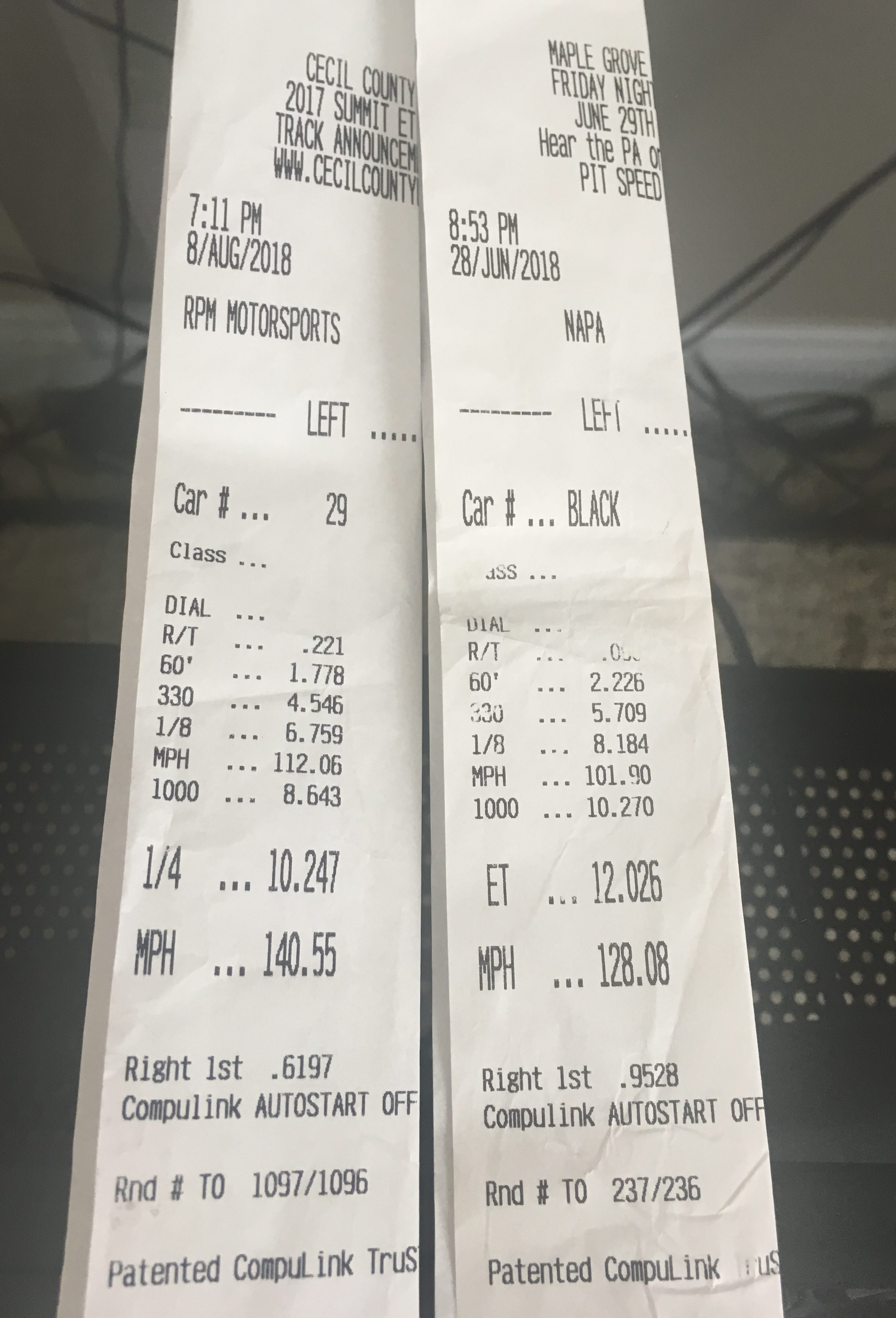
My ride back gave me a lot to think about it. It also gave me a nice hard rain storm in the dark. Where is my truck and trailer I laughed to myself? I will stay the course for this project I told myself. It’s all part of the fun.
Thanks a lot for all the positive feedback, tips and support. I appreciate every bit of it and I am excited for the next chapter in this project.
And remember, please share this with your non-drag racing friends who have street bikes, because if a rookie like me can go out there, so can they! And if you are the rookie, c’mon out and have some fun. You may just not be able to put this hobby down.
Please be sure to like and follow the Cycledrag.com Facebook page for more
Please visit Brocks’ site to buy the Stage One Kit or any of his other outstanding components. If you are doing a home remodel demand your contractor use Trim-Tex Drywall Products. And if you are a rookie like me in drag racing, meet me at the Rickey Gadson Drag Racing School! Please click on all the banners below for more info.


